Timing of clean-car changes under fire

Government’s revamp of feebate scheme will impact on rebates for hybrids and small cars – and the charges for light commercials
The relaunch of the clean car discount (CCD) has been criticised because of the short timeframe for the industry to adjust before the changes kick in.
There are also concerns segments of the market will become more expensive for consumers with many fuel-efficient hybrids set to attract lower rebates or miss out altogether, and utes getting pinged with bigger penalties.
The Motor Industry Association (MIA), Imported Motor Vehicle Industry Association (VIA) and Motor Trade Association (MTA) have condemned the roll-out date of July 1 for the overhauled CCD as too soon because it risks creating disruption across the industry and its supply chain.

The government’s announcement on May 2 means rebates will soon only apply to imports emitting up to 100g of carbon dioxide (CO2) per kilometre instead of the current 146g limit.
The discount for models emitting between 1gCO2/km and
100gCO2/km – generally plug-in hybrids (PHEVs) and smaller petrol hybrids – will fall by about $1,500 to $1,750 for new and by $200 to $500 for used, according to the Ministry of Transport (MoT).

The rebate will be $1,725 for a vehicle at 100g, plus $57.50 for each gram below that level for new vehicles up to a cap of $4,025. Used imports will receive half of the dollar amount for new vehicles.
Meanwhile, the maximum rebate for new battery electric vehicles (BEVs) is being reduced
from $8,625 to $7,015 and it will increase from $3,450 to $3,507.50 for used.
The threshold for when imports attract fees will drop from 192gCO2/km to 150g. Fees will be set at $575, plus $57.50 for each gram above 150g for new imports and half that amount for used.
An updated formula will be applied for calculating fees for passenger vehicles emitting 192gCO2/km or more, which the MoT notes will increase charges.
As a result, the maximum charge for vehicles “with very high


[continued
GLOBAL VEHICLE LOGISTICS NZ - JAPAN - AUSTRALIA - UK - SINGAPORE MAY 2023 www.autofile.co.nz THE TRUSTED VOICE OF THE AUTO INDUSTRY FOR 35 YEARS p 23 Bigger and better credentials Marque issues emissions warning p 12
needed for smart chargers p 8
star’s drive to recovery p 24
on page 4]
Incentives
Rising
CCD rebates for many petrol hybrids will be lower from July 1
LOAD IT SHIP IT TRACK IT CLEAR IT DELIVER IT !
BIGGER IS BETTER
move to new, much larger premises means we are to offer even more services to our dealer clients
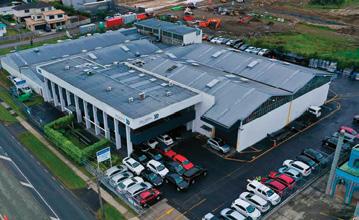

to door ro-ro vehicle shipping from Japan and Australia
Containerised vehicle shipping from anywhere in the world

Vehicle tracking
VEHICLE SHIPPING
Approved MPI transitional facilities and cleaning services

GENERAL FREIGHT

VEHICLE TRACKING

SHIPPING SCHEDULE
Capping it all off is Jacanna’s SmartTrade Rewards Programme, you can earn points for almost any reward you choose

We are specialists in transporting and exporting all types of Vehicles, Commercial trucks, vehicles of Special Interest and other RORO Heavy Cargo & Machinery.
We have developed a worldwide network of Agents who understand the commitment required to service our demanding market.

Finding out where your vehicle is at any one time of the process, gives you the ability to manage the collection and processing of documents and payment on time.
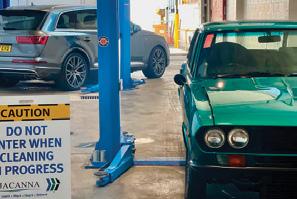
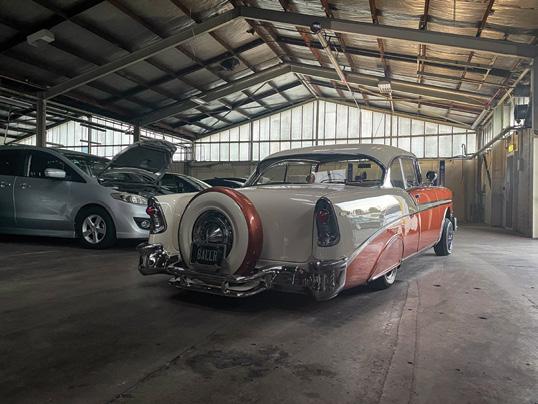

TRS and shipping services from Japan to New Zealand. www.jacanna.co.nz

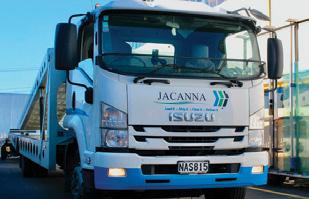


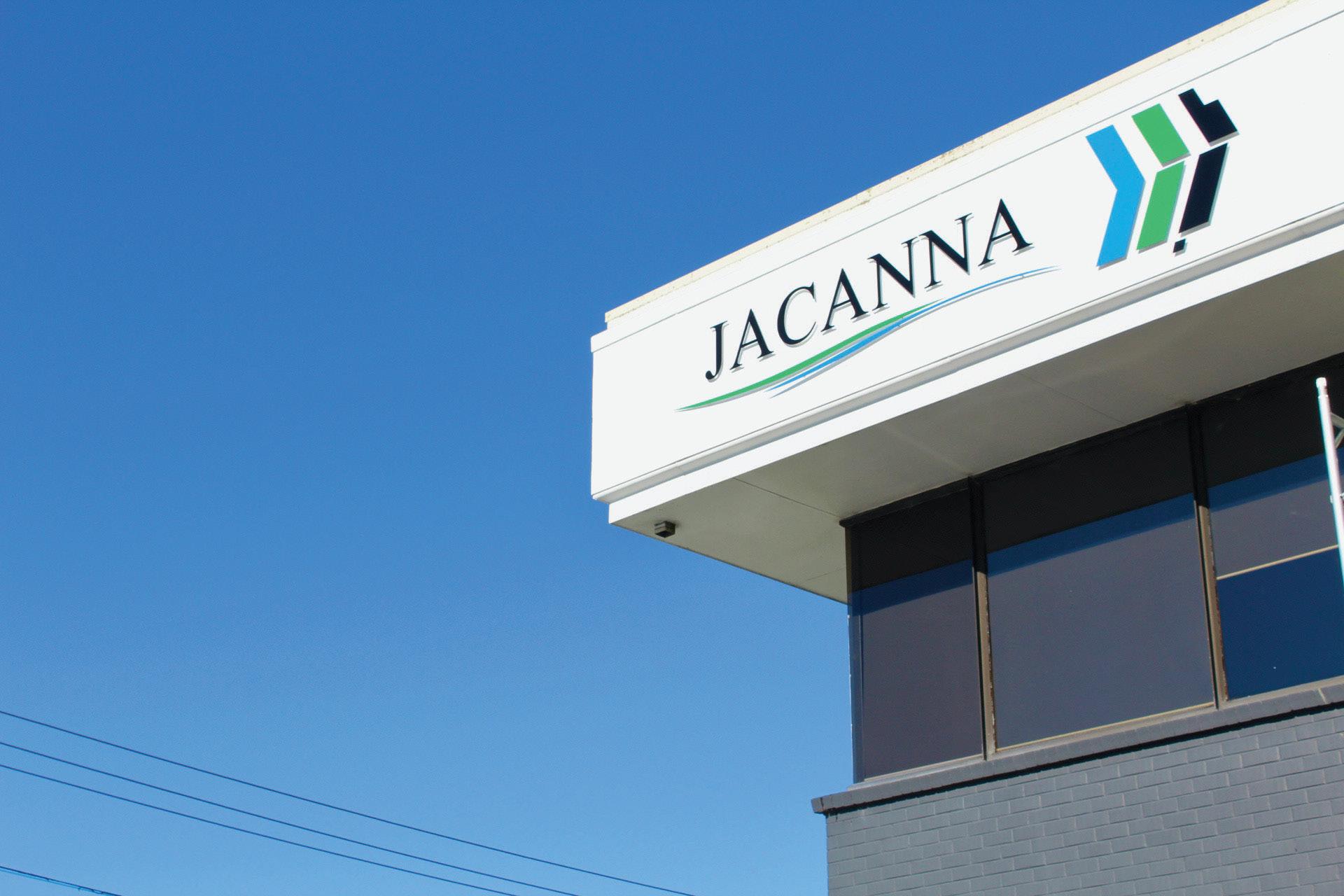

JACANNA.CO.NZ
www.jacanna.co.nz Tel: +64 9 825 0888
info@jacanna.co.nz Tel: +64 9 825 0888 Terms and conditions apply.
Conundrum facing energy transition
Mobility, for the past 120 years, has been powered by relatively cheap and easy to obtain oil.

The automobile brought mobility to the masses helping to solve one of the great environmental challenges of the day. Yet solving one problem can have unintended consequences.
In the late 1800s, civilisations relied on horses, but pollution and disease became rife – just imagine 50,000 horses in London each dropping 7-16kg of manure and more than one litre of urine per day.
In 1894, The Times predicted that “in 50 years, every street in London will be buried under nine feet of manure”.
The situation was debated in 1898 at the world’s first international urban planning conference, but without resolution. It seemed urban civilisation was doomed.
Then the car arrived, problem solved. While there were steam and electric vehicles (EVs), the internal combustion engine (ICE) car became most popular – powered by oil that was plentiful and cheap.
Yet, as mobility evolved, again came unintended consequences and climate change has become apparent. Governments have declared carbon footprints must reduce, and policies targeting the transport sector have been developed to reduce oil consumption and encourage renewable energy generation.
There seems to be some serious headwinds we must battle first.
If we were amid a transition away from petrol to renewables, there would be no desire or sense to invest in oil and gas exploration, and the market would be receiving signals these fuels are no longer needed. However, it’s quite the reverse. Despite minor fluctuations driven by external economic conditions, there’s steady, resilient and increasing demand for oil and gas. This year, world oil demand is forecast to rise by an average of two million barrels per day to 101.9m.
As global GDP will double by 2050, demand for energy in any form must grow massively. To save the planet, we must transition to renewables, yet oil and gas are still needed for decades to come.
When the world exploited oil in the 1950s, it was easy to find and cheap to extract. In energy terms, only a small amount was needed to extract large quantities. Today around 15 per cent of that oil is needed to extract new discoveries. By 2050, it will take 50 per cent of what’s extracted.
New Zealand’s emissions reduction plan requires 1.5m more battery EVs by 2035. We have just over 15,300 in a fleet of 4.5m. That’s 0.34 per cent.
Although sales of zero-emissions cars will increase and become a larger part of the mix, it’s not yet time to swap your spanner for a computer. The future for the next few decades will be ICEs. And EVs, public transport, walking and cycling will provide complementary options.

DIRECTORS
Brian McCutcheon brian@autofile.co.nz

ph. 021 455 775
Darren Wiltshire dazzz@autofile.co.nz
ph. 021 0284 7428
DESIGNER
Adrian Payne arpayne@gmail.com
EDITOR
Darren Risby ris@autofile.co.nz

JOURNALISTS
Sue Brebner-Fox sue@autofile.co.nz
Matthew Lowe matthew@autofile.co.nz
MOTORSPORT
Mark Baker veritas.nz@xtra.co.nz
Autofile magazine is also available online as a readable file or downloadable as a PDF. Subscriptions are available at Autofile Online – www.autofile.co.nz Back copies are also available on the website.
Copyright: Published monthly by 4Media Ltd

All statements made, although based on information believed to be accurate and reliable, cannot be guaranteed, and no liability can be accepted for any errors or omissions. Reproduction of Autofile in print or digital format in whole or part without written permission, whether by copying or any other means, is strictly forbidden.
All rights reserved. ISSN 0112-3475 (print) ISSN 2350-3181 (online)
www.autofile.co.nz 3 Vehicle Inspection NZ Entry Certification Specialists 0800 GO VINZ VINZ.CO.NZ • Entry Certification • Vehicle Appraisals • Pre-Purchase Inspections • Warrant of Fitness (WoF) • Certificate of Fitness (CoF) • Road User Charges • Registration & relicensing • Exhaust emission testing
Call Steve Owens now on 021 947 752 GUEST EDITORIAL
TERRY COLLINS AA’s principal policy adviser
Serious headwinds must be battled before we can switch to renewables, says Terry Collins
emissions” will rise from $5,175 to $6,900 for new and from $2,875 to $3,450 for used.
In addition, a rebate for new and used low-emissions disability vehicles is being introduced. This will be $11,500 for BEVs, and $5,750 for PHEVs and hybrids.
Kit Wilkerson, VIA’s head of policy and strategy, says the changes to the CCD will affect bigger hybrids from July 1 because of the rebates they will be attracting.
There will continue to be credits on small hybrids, “with BEVs and PHEVs being the best options”.
He told Autofile some light petrol hybrids will see their rebates fall. For example, those for many Toyota Aquas will decrease from the current $1,700 to $1,000 or $1,100.
Many heavier petrol hybrids will probably go into the zero band with no rebates or charges being applied. Some will start to be penalised.
“CO2 ratings of 150g/km is
New vehicles: CCD rebates and fees from July
the new rebate and fee settings.
“Customers have committed to purchasing vehicles and have paid deposits in good faith, expecting to know the overall value of that commitment,” she says.
“The CCD changes announced by Minister [Michael] Wood mean most hybrid vehicles that haven’t got a plug will no longer qualify for a rebate. Customers will likely have to pay more for these vehicles from July 1.”
Emissions ranges shown are a guide. Some vehicles may have higher or lower emissions.
where penalties will start to apply on used imports, which is a normalsized family car,” he says. “This will add significant market pressure to bring in cleaner cars.”
The top six used imports in New Zealand up to the end of April, in order, were Toyota’s Aqua and Prius, the Mazda Axela, Toyota Corolla, Honda Fit and Nissan Note.
When combined, their first-time registrations accounted for 40.1 per
cent of the market for the first four months of this year, with many of those being traditional hybrids.
The Aqua, which made up 15.2 per cent of the year-to-date total, will continue to attract rebates.
Wilkerson says from model-year 2013 onwards, it is likely to attract a slight decrease in credits and from 2017 these will be about the same.
Toyota’s Prius PHEV will attract a higher rebate after Waka Kotahi’s system changes to align used plugin hybrids with new PHEVs. This will be the same with PHEV variants of the Corolla and Note.
The Prius Alpha and pre-2012 models will fall into the zero band, while newer petrol hybrids will attract rebates of around the same levels as now.
When it comes to the Axela, older models will start attracting heavy penalties while hybrids and model-year 2015 onwards will fall into the zero band or attract slight credits depending on the variant.
As for non-PHEV Corollas, hybrid variants are likely to get slightly higher discounts than similar Aquas with others being landed with penalties, says Wilkerson, while Nissan Notes that are post2012 will fall into the neutral zone with models before that year facing penalties.
The MIA predicts the financial impact of the CCD changes will be considerable for the new-vehicle industry and its customers.
Aimee Wiley, chief executive officer, notes there are wait lists of up to 12 months for models from some brands, and the prices of these vehicles may be impacted by
She adds it’s “surprising and disappointing” to only get two months’ notice from the government for the amendments to its policy that will have significant consequences.
“Ever since we started discussing the clean-car scheme with officials, the key message has always been to allow adequate time and notice of change.
“The new-vehicle industry is typically committed to specific vehicle orders in advance, usually up to 12 months in advance.
“Not allowing adequate time for industry to adapt to these changes creates significant and unnecessary commercial consequences. We’ve always said at least six months’ notice is preferred.”
Wiley notes it’s also disappointing that the majority of non-plug-in hybrids will no longer qualify for rebates because they represent a more affordable pathway toward lower-emissions vehicles for many.
“The CCD has proven that rebates influence customer demand for lower-emissions vehicles,” she told Autofile.
“Let’s hope the removal of rebates from non-plug-in hybrids doesn’t undermine the ultimate goal of reducing vehicle emissions from the fleet.”
The MIA welcomes that eligibility criteria for the CCD will remain the same, namely the $80,000 cap, which addresses inflationary pressures for newvehicle prices.
But it is disappointed its request to create a specific cap for light commercials at $85,000 seemed a step too far for the government, the consequence being that these vehicles are “disproportionately
4 www.autofile.co.nz
If you are a forward thinking motor vehicle trader, or financier, looking for a trusted vehicle insurance partner, call Quest. Contact: Russell Bowater 021 790 365 russellb@questinsurance.co.nz QUEST INSURANCE OFFERS: an independent choice Mechanical Breakdown Insurance – backed by AA Roadside Assist Comprehensive Motor Vehicle Insurance Lifestyle Protection Insurance Credit Contract Indemnity Insurance Mechanical Breakdown Insurance for Electric and Hybrid Vehicles Guaranteed Asset Protection Insurance
news [continued from page 1]
CO2 emissions (gCO2/km) Emission ranges shown here are a guide. Some vehicles may have ower or higher emissions. $6,900 maximum fee $5,175 maximum fee $8,625 maximum rebate $7,015 maximum rebate -$2 000 $0 -$4 000 -$6 000 -$8 000 -$10,000 $8 000 0 50 100 150 200 250 300 $6 000 $4 000 $2 000 Key Pricing from July 1, 2023 Pricing until June 30, 2023 BEV (0g) Petrol/diesel van/ute (200-300g) Petrol/diesel car (120-200g) Hybrid (80-130g) PHEV (20-70g) High-emissions vehicles incur fees Low-emissions vehicles get rebates
[continued on page 6]
Source: Waka Kotahi
Data-driven solution for dealers


At Apexdealerdata.com, we’re passionate about helping car dealers succeed in today’s competitive, ever-changing market. We believe data is the key to making informed decisions and our platform is designed to provide you with insights you need to stay ahead of the curve.
Our team is made up of experienced professionals from the automotive industry and tech world. They have come together to create an AI-driven platform that meets the unique needs of car dealers. We understand the challenges you face every day and we’re dedicated to providing you with the tools you need to overcome them.
We offer a suite of products specifically designed for the New Zealand car-dealer industry, including a live data insight of your dealership, Apex Benchmark Data and Apex Wholesale.
With these tools, dealers have access to real-time data, predictive analytics and detailed market insights to help you make better, data-driven decisions, and find the right stock at the right price.
Apexdealerdata.com is a cloud-based AI-driven platform that aggregates car data from the market. It creates reports providing insights into how your business is performing and pinpoints where it could do better.
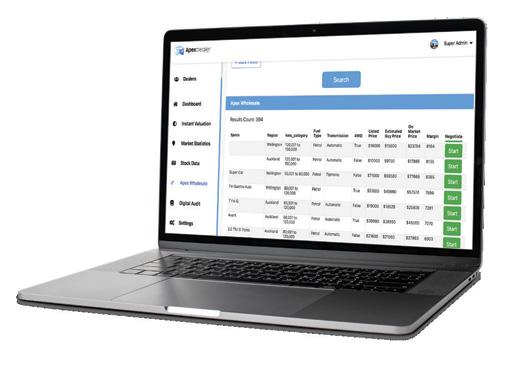
No longer do you have to wait until the end of the month to see if you’re making money or not. You get a live view of what the overall market is doing and how your dealership is performing. You can reduce reliance on staff knowledge when making buying decisions and use exclusive data so you don’t buy the wrong stock.
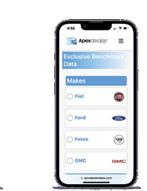
APEX DASHBOARD This main screen gives you benchmark data that allows you to compare your dealership versus the market. It provides data points on your dealership allowing you to clearly see where your attention needs to go. Features include stock level, average stock price, average stock age, sales last week, sales this month and how your pricing compares to the market.
MARKET STATISTICS This takes into account every car sold in the past few months, the price band and how long it took to sell. The key for any dealership is not buying the wrong stock. We can show you which makes and models are moving but, most importantly, if you buy this black colour car on average it will sell in 42 days versus the same make or model in white, which takes 85 days. The myth is just buy black, white and grey as they are the fastest-moving colours, but our data confirms it’s model dependent.
APEX WHOLESALE 45-50% of an average dealer’s stock comes from trade-ins or buying cars off the public. This is a painful and expensive way of searching for the right stock at the right price, or to use an analogy, “it’s like looking for a needle in a haystack”. Our AI-driven data platform allows you to search every single car for sale privately across the whole market with the most margin, simply at the click of a button. This reduces the process from hours to seconds.
You can see, for example, what Toyotas are for sale and what margins are in them in seconds anywhere in New Zealand. By adding our market statistics, you also know what makes, models and colours are the fastest moving. It’s a very simply process.
Apexdealerdata.com allows dealers to feel in control of their own destiny and eliminates the risk of human error. AI-driven platforms are the future and the future is here now.

www.apexdealerdata.com
impacted” by the changes in fees.
“The MIA anticipated a reduction in rebates, an increase in fees and adjustment to the bands for eligibility for rebates,” says Wiley.
“Unfortunately, reducing the point at which a rebate begins from 146g to 100gCO2/km excludes almost all hybrid vehicles from qualifying for a rebate from July 1.”
The MTA warns the changes to the CCD may have little effect on sales of EVs and light commercials, with both categories already facing market challenges.
Tony Everett, the MTA’s sector manager – dealers, notes it’s difficult to forecast exactly how the shake-up of the feebate scheme may affect the fleet, while the clean car standard (CCS) will also have an influence.
“EVs are supply constrained and the CCD changes will do nothing to really change that outcome,” he says.
“An increase in fees on utes and vans might not change outcomes in those sectors because there are
no real alternatives that meet the ‘utility’ value required.
“The real questions must now centre on what happens in the market between those extremes –that’s to say, the hybrid and small ICE [internal combustion engine] sectors. Without incentives, will hybrids lose some volume – if so, that would be a shame.”
Everett adds the government’s aim in announcing its overhaul of
the CCD is to try to balance the ledger of the system that has paid out far more in rebates than it has received in fees.
“We ponder whether the actual plan is as good as it could be. Hybrids, where most of the transitional volume sits, have largely been taken out of the rebate side.
“At this time where we are still in the technology shift phase towards more fuel-efficient vehicles, we’re not sure that is the right move. Maybe it would have been better to reduce the numbers at the edges – lower the maximum rebates and fees, and flatten the line in the middle.
“The CCD is about sending a message to consumers, and that could have arguably been better achieved.”
Everett echoes industry concerns that the amount of notice the government has given on the changes is inadequate. He says having less than two months until the new regime is introduced provides no room for businesses to adjust.
“In the used sector, two months is insufficient given the much longer shipping times currently in play,” he says.
“The new-vehicle industry is caught by long lead times, so this timing will cause problems at an individual brand level. Some brands may be better placed than others.
“Our members operate in both the new and used dealer space. Sudden changes are hard for both sides because it gives them
to adjust their product mix before new rules apply.”
Wilkerson says VIA requested at least a three-month lead-in time before the new CCD kicks in and the used-imports sector has “major concerns” with the timeframe for main changes starting on July 1.
“We will see a rush on compliance shops,” he warns. “It will lead to a rush when it comes to complying vehicles that will now be getting penalties and were not before, which are those falling into the 150-200gCO2/km range.
“Clean, efficient vehicles, such as the Prius and Aqua, have already been purchased by dealers or imported in good faith and with certain expectations under one set of rules.
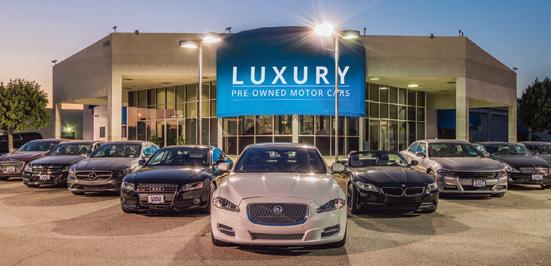
“Before importers can change their buying behaviour in Japan, some vehicles already brought into the country are likely to attract government penalties.”
Michael Wood, Minister of Transport, says the changes to the CCD will ensure the “highly successful” scheme will keep driving down CO2 emissions.
With more than 100,000 rebates granted since the scheme started in 2021, “we have one of the fastest uptakes of EVs in the world”.
Wood adds: “It’s exceeding industry and government projections with 20 per cent of all new-car sales being electric in 2022 – a substantial increase from eight per cent in 2021.
“The scheme is facilitating an increase in the number of EVs entering the fleet we didn’t expect until 2027. As planned, we are further targeting the scheme to maintain its success and ensure it will be self-funding until its next review.”
As part of the measures, the government will increase the CCD’s repayable crown grant by $100 million in this year’s budget.
Waka Kotahi is developing a system to treat used-imported PHEVs in the same way as new plug-ins, says VIA. The CO2 values currently applied to them for the clean-car policies are 20g/km for new and 87g/km for used.
Story – page 39
6 www.autofile.co.nz news
[continued from page 4]
no
Contact us now to find out more A better deal for the Motor Vehicle Trade Ph: 09 320 5646 www.autobridge.co.nz n Flexible credit facility available to fund vehicles in transit or on your yard n Access to stock when you want to buy, not only when you have the available cash n Free up your capital and grow your business n Only available to registered motor vehicle traders High-emissions vehicles incur fees $0 -$1,000 -$2,000 -$3 000 -$4 000 $4 000 0 50 100 150 200 250 300 $3,000 $2,000 $1 000 BEV (0g (200-300g) Petrol/diesel car (120-200g Hybrid (80-130g) PHEV (20-70g) $3,450 maximum fee $2,875 maximum fee $3,450 maximum rebate $3,507.50 maximum rebate Low-emissions vehicles get rebates Emission ranges shown here are a guide. Some vehicles may have lower or higher emissions. CO2 emissions (gCO2/km) Petrol/diesel van/ute Key Pricing from July 1, 2023 Pricing until June 30, 2023 Used imports: CCD rebates and fees from July Emissions ranges shown are a guide. Some vehicles may have higher or lower emissions. Source: Waka Kotahi
time
Protection from the cost of maintenance and unexpected repairs Coming soon! Talk to our team to find out more. shannon.beech@assurant.com | ross.coutts@assurant.com
Charging up needs smart policy
The Motor Industry Association (MIA) has voiced its support for an incentive scheme to encourage electric vehicle (EV) owners to buy smart chargers to help manage future demand for power as more low-emissions cars enter the fleet.
Its comments are part of feedback provided to the Energy Efficiency and Conservation Authority (EECA) in a green paper titled “Improving the performance of EV chargers”.
The crown entity sought submissions about chargers that are “smart” or demand-response capable, and the role these can play in managing intermittent renewable supply and peak demand as the number of EVs on our roads increases.
It says such technology can improve energy security, affordability and reduce emissions. “New Zealand stands the best chance of realising this potential if we start planning for an increase in EVs and EV chargers now, while we can influence the types of chargers installed.”
A submission by Mark Stockdale, the MIA’s principal technical adviser, says planning is necessary to ensure the electricity
distribution network can meet future demand, “considering the projected future growth of EVs and the fact that currently 80 per cent of EVs are charged at home”.
“The MIA supports that wall chargers should be ‘smart’ and that policies are needed to enable this,” he adds.
“Overall, our members endorse adopting a staged approach similar to the UK – introducing targeted incentives to accelerate the uptake of smart chargers, and then phasing them out and introducing regulations later.”
Stockdale explains intervention, such as information and education, to increase the uptake of the devices will be better than the status quo.
Education can be used to help consumers understand the benefits of smart chargers shifting charging to off-peak times, as well as cost savings in energy bills from doing so when compared to using a cheaper “dumb” charger.
FROM JAPAN TO NEW ZEALAND ON TIME, EVERY TIME
The MIA also supports temporary incentives to reduce the upfront price of smart chargers, “not unlike the clean car discount [CCD], which has helped reduce the price of electric and low-emissions vehicles”.
“Such an incentive scheme could be modelled on the UK’s EV home-charge scheme, perhaps funded from a budget allocation, as is the CCD initially, or from emissions trading scheme [ETS] revenue, or by the electricity sector since it is the primary benefactor,” adds Stockdale.
“These incentives could be withdrawn once smart chargers dominate market share like they do in the UK.”
He says subject to monitoring the uptake of smart EV chargers after implementing incentives and education campaigns, regulation could be considered later down the line if “dumb” chargers still comprise a reasonable market share.
BOOSTING UPTAKE

Drive Electric was also among the 86 groups and individuals to provide views on the green paper. It notes any measures around smart chargers should enable the creation of a demand-response market in the interests of end users and in support of decarbonisation.
“Smart charging will help make the most of New Zealand’s existing electricity infrastructure and avoid unnecessary capital investment by helping manage peak demand,” it adds.

“It’s critical measures are taken to support widespread adoption of smart chargers in parallel with the adoption of EVs.”
The not-for-profit organisation says it supports exploring the idea of a government subsidy to overcome barriers to the uptake of such chargers.
Drive Electric believes two types of incentives need to be considered. One is financial incentives from the market around pricing and the other is government subsidies, which would be accompanied by regulation.
“Our view is that to stimulate the rapid uptake of smart chargers in-line with principles set out in this paper, both are necessary,” it states.
TOYOFUJI SHIPPING SCHEDULE
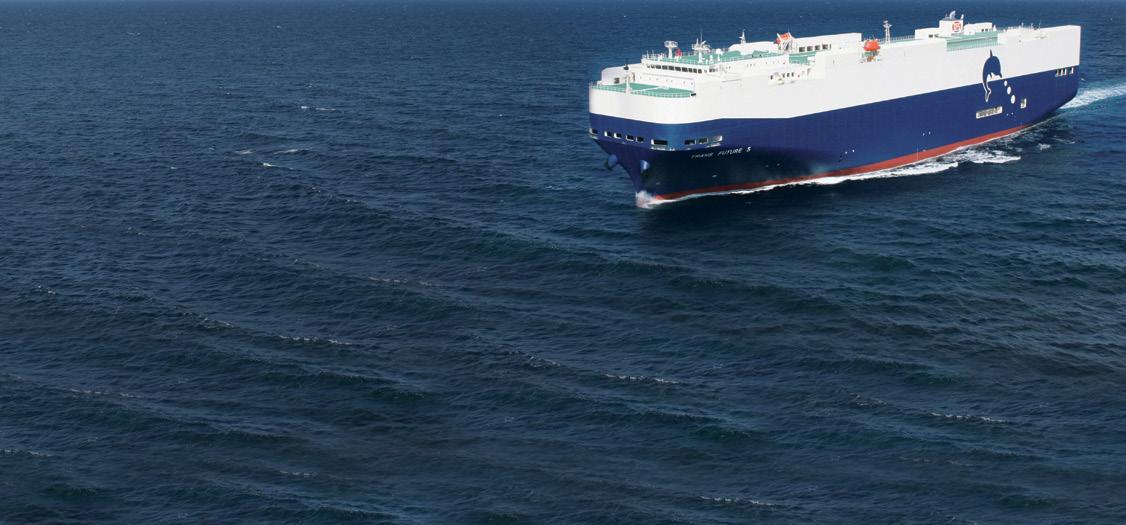
8 www.autofile.co.nz Contact:
www.toyofujinz.co.nz
Adam Stone adam.stone@toyofujinz.co.nz
T/S = Tranship to next available TFS vessel Toyofuji
JAPAN NEW ZEALAND
Auckland
Trans Future 7 143 10 Apr 11 Apr 15 Apr 6 May T/S T/S 9 May Dream Jasmine 26 27 Mar 29 Mar 14 May 17 May 19 May 20 May New Century 2 178 3 May 1 May 27 Apr 28 Apr 17 May 21 May 23 May Trans Future 5 147 7 May 9 May 13 May 27 May 30 May 1 Jun Fujitrans World 317 9 May 13 May 31 May T/S T/S 2 Jun
vessels Voyage
Moji Osaka Nagoya Yokohama
Lyttelton Wellington Nelson
news
Mark Stockdale, the MIA’s principal technical adviser
t
“Without incentives to support uptake we expect the expense of installing or retrofitting a smart charger will be a barrier to EV uptake as this creates a further cost on top of the vehicle.
“A key consideration is time. We want consumers to switch to EVs today for carbon-reduction purposes rather than wait. This provides a justification for a welltargeted subsidy to support EV uptake.”
Drive Electric adds subsidies need to be designed so they are financially sustainable over time, easy to administer, create no unforeseen or undesirable market distortions and recognise technology is evolving, so incentives need to be flexible.
It highlights that lessons can be learned from schemes in Canada, China, the EU, India, Japan and the US, which provide either direct subsidies or tax rebates.
“We don’t yet have a specific view on the design of the subsidy in New Zealand, but we note that in most

Battery electric-vehicle uptake scenarios: 2020-35
EVs to have significant impacts on electricity systems.
Its submission lends support to the adoption of smart chargers that are subject to regulated standards and supported by time-of-use pricing and demand-response capability.
Terry Collins, the AA’s principal policy adviser, adds smart technology can make charging EVs cheaper and safer for motorists.
MoT CCC BEV: Ministry of Transport clean-car modelling results – based on current policies, including the clean car discount and standard
CCC PATH: Climate Change Commission’s demonstration path – based on measures and actions that would deliver its recommended emissions budgets
TIMES-NZ-KEA: NZ Energy, TIMES-NZ KEA scenarios – based on when climate change is the most pressing issue, and on EECA and BusinessNZ Energy Council modelling
This graph shows EV uptake forecasts from several government sources. It excludes plug-in hybrids. Despite a wide range of estimates, there is a common theme of rapid BEV uptake across all of them. It is anticipated most EV charging activity will continue to be residential. Source: EECA
jurisdictions they are offered by the government,” notes Drive Electric.
“There may be a way to design the incentives so they are costneutral – or close to – similar to the intent of the CCD being funded by penalties on higheremitting vehicles.
“For example, this could be
funded through taxes collected on fuel or the ETS. In that way, the incentive becomes a ‘green redistribution’.”
MEETING DEMAND
The AA expects the replacement of a large proportion of New Zealand’s light-vehicle fleet with
“Our current grid will not handle these new loads in electricity caused by large-scale EV charging,” he explains.
“To meet this demand, significant extra investments will be necessary to upgrade networks that supply electricity and our generation capacity to provide it. This could mean electricity prices increase for consumers.
“If charging continues to rely on regular charging points, which simply supply power at a standard rate until the vehicle is fully charged, this could cause real issues for EV owners.”
[continued on page 10]
www.autofile.co.nz 9
news
200,000 0 400,000 600,000 800,000 1,000,000 1,200,000 1,400,000 1,600,000 20 2 0 20 2 1 20 2 2 20 2 3 20 2 4 20 2 5 20 2 6 20 2 7 20 2 8 20 2 9 20 3 0 20 3 1 20 3 2 20 3 3 20 3 4 20 3 5
MOVING FORWARD
Megan Woods, Minister of Energy and Resources, has been briefed on the summary of submissions to the green paper and will be kept informed of further actions taken by EECA.
The summary, which has also been made publicly available, reports the vast majority of submitters agreed that some form of intervention to accelerate the uptake of smart chargers is needed.
Some electricity distribution businesses provided estimates on the potential impact of the unmanaged use of “dumb” chargers on the network.
Vector suggests unmanaged EV charging may increase peak demand by 150 per cent. Meanwhile, WEL Networks predicts that, by 2040, significant additional infrastructure investment – equivalent to 1.3 times its current asset base – will be required.
“The vast majority of submitters didn’t support the ‘do nothing’
option,” notes EECA. “They felt some form of intervention is needed to safeguard our electricity system and realise the full benefits of a functioning demand response or demand flexibility market.”
Other submitters felt the current market is too small to provide solutions in the time required. There was plenty of support for subsidies or rebates to support installing smart chargers, with concerns the upfront cost for such devices of between $1,000 and $3,000 will continue to be the largest barrier to them being adopted by Kiwis.
“However, a few submitters suggested any incentives for smart chargers are not a long-term solution. Rather, they should be
used as an interim solution to ensure effective public spending and or allow time for the market to develop.
“This was the case in the UK where incentives were offered for three years driving adoption to between 70 and 100 per cent where, over that time, the industry was able to develop to ensure charger installation was no longer prohibitive.”
Murray Bell, EECA’s group manager of strategy insights and regulations, says the green paper didn’t contain specific proposals, but was designed to stimulate discussion on EV charging to better understand the government’s role in that space.

The paper was developed in consultation with partners, such as the Ministry of Business, Innovation and Employment and Electricity Authority.
As the submissions show general support for some market intervention, EECA has started a regulatory impact analysis on specific or combinations of actions it could take.
“Ultimately, government intervention could look like a mix of regulation, information campaigns, and or subsidies or other incentives to smart-charger uptake,” explains Bell.
“We expect to release a
Save the date
T-Tech, New Zealand’s leading transport technology conference, returns in September with its theme being “advancing safer, smarter, sustainable transport for everyone”.
Connected, automated and low-emissions vehicles, shared, public and integrated mobility, and data equity and accessibility will all be covered.
The two days will include presentations on innovations, emerging solutions, research and
discussion document later this year to test the options with the public and industry. The minister will be kept up to date as that work progresses and it will need to go through cabinet before release.”
The green paper and submissions are also being used to inform EECA’s work programme related to enabling the development of electricity demand-response programmes and demand-flexibility systems.
“In these systems, energyusing products such as EV chargers and hot-water cylinders can engage with the electricity system and respond to market signals by changing when and how they use electricity, with no impact on their operability or effectiveness,” says Bell.
“This can help to manage intermittent renewable supply and manage peak demand, both of which are essential to the success of delivering energy security and affordability alongside decarbonisation.
“EECA’s focus continues to be working across government and industry to expand publiccharging infrastructure through our input into MoT strategy. We are also committed to co-funding public charging through the Low Emissions Transport Fund.”
EECA also carries out regular research into public attitudes towards EVs and its latest Consumer Monitor found 50 per cent of New Zealanders would consider an EV for their next vehicle.
trends that are shaping the future of transport.
The conference brings together the sector for discussion and networking, and includes exhibition of solutions and expertise. It will be attended by government and business leaders, technology and engineering specialists, researchers and innovators.
T-Tech 2023 is being held from September 26-27 at Takina Convention Centre, Wellington. Email simon.mcmanus@itsnz.org for sponsorship and exhibition opportunities.
10 www.autofile.co.nz
[continued from page 9] news
Contact us today 09 966 1779 www.jevic.com SP E C I A L IS T S I N PRE‑SHIPMENT INSPECTIONS MPI biosecurity inspections Biosecurity decontamination Heat treatment NZTA border inspections Odometer verifications Pre-export appraisals ? Lost documentation reports
Murray Bell, EECA’s group manager of strategy insights and regulations
a faster and more flexible way to get behind the wheel
New Zealand’s non-bank vehicle lending specialists, just got faster and even more flexible.

We offer a first-tier proposition, second-tier finance options, and wholesale floorplan finance. Our flexible solutions get your customers on the road faster and keep you moving forward with automated systems for smooth, uninterrupted journeys.
We provide access to an experienced team of lenders, outstanding personalised seven days a week service and nationwide coverage. We work where you work.
Curious to find out more?
Lee Robson, National Sales Manager, NZ Dealer 027 688 9895 | lee.robson@avantifinance.co.nz
Nicole Remkes, NZ Broker Manager, Auto & Consumer 021 599 729 | nicole.remkes@avantifinance.co.nz
www.autofile.co.nz 11 Lending criteria, fees, terms and conditions apply.
*For complete and correct applications which meet our responsible lending criteria. Fees, terms and conditions apply. Our process will take longer if the application is not complete and/or we require further information in order to make a credit decision. NEW VEHICLE FINANCE brandedfinancial.co.nz USED VEHICLE FINANCE avantifinance.co.nz
Slow road to emissions drop
The new chief operating officer at Mitsubishi Motors New Zealand (MMNZ) says despite the best efforts of carmakers and governments, it will still be some time before the country’s transport emissions tumble.
Tony Johnston says the industry and officials are putting more emphasis on low and zeroemissions models – including Mitsubishi, which plans to launch a number of pure electric vehicles (EVs) over the next five to seven years.
However, he notes the current number of sales each year in New Zealand and the prices for new, cleaner models are likely to limit how quickly the fleet’s emissions drop.
“There are four million cars running around our roads and we’re selling 130,000 to 140,000

new vehicles a year, so it’s going to take a significant time to decrease the age of the fleet and emissions by just selling EVs. But I suppose you’ve got to start somewhere,” Johnston told Autofile.
“As a country, we have signed up to lowering our overall emissions and the auto industry is seen as a fairly easy target to achieve some of those goals. The rules are what they are and we have to work with them.
“Ultimately, EVs aren’t going to get fundamentally cheaper so we will need big incentives or a higher tax rate on other cars to close the price gap. That’s what most governments, including our own, will probably do.
“That will make cars less affordable and if people buy fewer cars the ICE [internal combustion engine] fleet will remain, will age and offset any gains from electrification.”
Johnston, who started in his new role in April, predicts there will still be a reasonable market for vehicles with ICEs through to 2030 and possibly beyond. He describes PHEVs as a strong transition product in the short to medium term that can help people as they eventually move towards full electrification.
his recent promotion to chief operating officer – succeeding Daniel Cook who has joined New Zealand company Power Farming – and his association with the company dates back to the early 1990s.
His career in the automotive industry started in 1991 as a used-car salesman at Kirk Motors in Wellington before he shifted to MMNZ’s head office about 18 months later.

He left in 1995 to spend three years in the UK before returning to the three-diamond marque for a spell as corporate sales manager.
Johnston then spent 13 years in senior roles across the vehicleleasing sector before reuniting with MMNZ in 2013 as national fleet-sales manager.
The company has changed substantially over the decades, shifting from being productionled to becoming a “nimbler” operation focused on importing and distributing models through its dealer network.
“When I first worked with MMNZ, we were still assembling vehicles here and producing cars, vans, utes and trucks,” recalls Johnston. “There was something like 1,600 to 1,700 people in the company. Automotive was a massive industry for Wellington back then with many car manufacturers based here.
“We were number two or three in the market at the time, although it was a much smaller market than now. When I left in 1995, I think the total new-vehicle market was about 80,000 units a year compared to the 140,000-odd now being sold.”
We are
looking
for NZ-new

with less than 150,000km
Fords and Mazdas. Ideally 2012 or newer
If you
have something you'd like priced, contact
Jason: 0274 133 222
| jason.robb@southaucklandmotors.co.nz

“There will be early-adopter customers who want to go pure EV and we don’t have a product that caters to that need at this stage. Equally, there’s still a big chunk of the market that doesn’t want to go fully electric yet.”
Johnston was head of sales at MMNZ for five years before
He adds the transition to his new role has been smooth. He has a lot of history with the brand and the executive team works closely together.
“The great thing with MMNZ is that we have a flat structure. I’ve sat directly next to Dan Cook for the past five years, who sat next to Warren Brown, the MD, who sat opposite Reece Congdon, our
12 www.autofile.co.nz
news
Tony Johnston’s association with Mitsubishi stretches back to the 1990s
head of marketing and corporate affairs.




“I’m proud and thankful to be in this role. When I first started as a used-car salesman at Kirk Motors, I never thought that I’d one day be in a senior position at MMNZ.”
Johnston notes with the company importing all its models, it now works in a closer and more consultative manner with its dealer network than in the 1990s and can react to market changes more quickly.
This was evident during the coronavirus pandemic when Mitsubishi’s sales success led to it being crowned the top passenger car brand in New Zealand in 2022.
He describes last year as exceptional for the company –“the biggest in the history of the business” – and admits it has benefited in recent times from people not being able to travel overseas because of Covid-19 restrictions and having more disposable income.
“We were dynamic and innovative, and were able to be nimble and change what models we were able to bring in during that period. That meant we kept having a good volume of vehicles available to the market.
“The strength of our dealer network was also apparent. We have incredible people right across the business and the dealers are the people on the frontline dealing with our customers on a day-to-day basis.
“The market is now changing again. There are more constraints
on production capacity at MMC [Mitsubishi Motors Corporation], but we’re still getting more than our fair share of models in New Zealand.”

Securing sufficient supplies of components such as semiconductors from China for its factories in Japan has been a major problem for the brand, an issue that has affected the new-vehicle sector over the past few years.
“Another factor is shipping and it’s frustrating to have vehicles made and ready to come to us but not able to get to us,” adds
Johnston. “It’s not just because of capacity, but also delays in ships transiting through Australia. A lot of our product goes through Australia and they’re having a lot of issues there.
“The combination of production and shipping delays means as a company we’re returning to pre-Covid volumes, which are strong but not the same as the numbers we were putting on the board during Covid.
“We have had a fantastic run recently and we’re now going to a slightly more challenging time and
www.autofile.co.nz 13 Why not ask what SBL can do for you? Every year we import thousands of vehicles into New Zealand. We manage every detail of the importing process from Japan to your door. For our approved customers SBL Finance can provide flexibility in funding a vehicle’s purchase. Ph. 03 377 6578 www.sbltd.co.nz Call us now and find out what everybody’s talking about. t news [continued on page 14]
Supply of the Outlander PHEV and entry-level ASX in New Zealand is falling short of demand
an election year is also always a bit challenging.
“Some of the challenges we’re facing are things we can’t control from here in New Zealand. MMC has said things should come right in the second half of this year, and the signals from suppliers and shipping companies are also that they will come right.”
With those headwinds expected to ease, Johnston remains confident of MMNZ’s fortunes improving after a slow start to 2023. The company secured 14.8 per cent of all new passenger vehicle sales last year. It slipped to be the fifth bestselling marque over the first three months of this year with 7.3 per cent of the market.
Johnston says the company has a “massive bank of forward orders” across its range, which will lead to it posting a strong second half when those vehicles get delivered.
MMNZ is also making sure it still has a number of models and stock available across its dealer network to sell, but he concedes those vehicles aren’t always exactly what consumers are after.
For buyers wanting a new Mitsubishi not already in a showroom, the wait is currently about three to four months. For some of its “high-grade” plug-in hybrids (PHEVs), the delay for delivery can be nine-plus months.
In particular, supply isn’t currently keeping up with demand for the Outlander PHEV and entrylevel ASX, which is popular with buyers “stepping up from used and into their first new car”.
Johnston notes the clean car discount (CCD) has been the issue of most concern for the newvehicle sector recently as it waited for the government to announce changes following a review of the scheme.
Michael Wood, Minister of Transport, finally revealed this month how the feebates scheme will be overhauled from July 1 with rebates and charges applying at different emissions levels for new and used imported vehicles.
“We’re working on model plans for the next five to seven years, and it helps the industry to have
some certainty and targets to work towards,” says Johnston.
“If those targets change every year, it makes it that much harder. People forget New Zealand is a tiny market and the expectation that volume manufacturers can produce small batches of models for the New Zealand market is unrealistic.”
Moves by the federal government in Australia to encourage more EVs and lowemitters into the fleet there will also help New Zealand to source such models “because so often our products are aligned with the Australian market”.
While the CCD is putting pressure on the new-vehicle industry, Johnston notes the clean car standard, which came into effect at the start of this year, isn’t such a problem for MMNZ.
“Some brands’ sticker prices will start to increase as they start to build in the costs of the standard. We still believe we will have significant PHEV sales to offset the emissions of those vehicles that don’t meet the standard so, in turn, we won’t have a fee [that needs passing on].”
With plenty of experience in the leasing sector, Johnston also recognises there are opportunities
and challenges for that part of the market amid the push to get more EVs on the road.
He notes leasing companies were initially cautious about moving away from ICEs, but are now increasingly at the forefront of the transition. A number of major corporations are also looking at the electrification of their fleets because they have to report their carbondioxide outputs and improve their environmental profiles.
“Leasing companies are taking risks on EV assets. Some new technology could come out that triples a vehicle’s range for half the cost, which means when everything out on lease comes back in two or three years’ time, those vehicles could be more expensive than what is newly available.
“The chances of that are fairly minimal but leasing firms are helping companies by taking on that risk.
“The bigger picture for fleets is the issue of recharging and having facilities at work. We have experienced it ourselves. Putting in chargers cost us several thousand dollars.”
Leases of passenger vehicles normally don’t go beyond 48
months and after that time they need replacing, which will see a number of EVs enter the general market.
Johnston predicts those cars will still be significantly more expensive than any leased ICE vehicles coming onto the market, “but it will at least put a volume of EVs” out there for general consumers.
Another challenge for marques is the increasing fragmentation of the market as a number of electric-only brands enter the fray.
“There are some big players, especially the Chinese brands coming to the wider market that have had dozens of years of government-sponsored investment and incentives to develop models.
“They are now reaping the benefits. They have come in, a bit like we did a couple of years ago, with new plug-in technology and appear to have timed it right. You could argue they will have more demand in the short term.
“It’s fragmenting the market, but it’s also giving consumers more choice and bringing more affordable EVs to the market.”
Johnston says regardless of what challenges the industry faces, MMNZ aims to be a solid foundation that its dealers and customers can rely on.

“We take on-board whatever changes happen and try to ensure the outcomes are the best for our dealers going forward. I want to be a strong, safe pair of hands and keep the ship going forward in the right direction.
“The industry is very strong. I personally don’t think we’ll see any players leaving. We’re fairly adaptable in New Zealand. There has been a bit of posturing from one or two brands that feel isolated by the clean-car changes, but we’re still going to be selling 130,000 to 140,000 plus new cars this year.
“As for MMNZ, we’re planning on another reasonable year, probably our third or fourth biggest year for revenue. We think there’s plenty of light in the tunnel and there’s not a train about to hit us.”
14 www.autofile.co.nz [continued from page 13] news
When I first worked with MMNZ, we were still assembling vehicles here Tony Johnston
Tony Johnston raises a smile at the MMNZ Diamond Dealer Awards


www.autofile.co.nz 15 “An app that makes your life easier? That’s a wing-wing situation.” Introducing the all-new MTF Finance Dealer App Our brand new app is the first of its kind in New Zealand. It means there’s no need to wait on finance reps or have awkward conversations with your customers to get them finance. We’ll sort the loan for you, with your commission paid on the spot. Talk about easy. Find out more at mtf.co.nz/join Helping New Zealanders do more since 1970 Offer of finance is subject to terms, conditions and lending criteria. See mtf.co.nz/terms for details.
Association seeks feedback
The Imported Motor Vehicle Industry Association (VIA) is drawing up a manifesto of its policies.
It has come up with a draft document and is now asking members for their input on the way forward.
It also covers a statement of purpose, VIA’s fundamental principles, its guide on government policy recommendations and code of conduct.
David Vinsen, chief executive, says the work aims to ensure an orderly transition to his successor and, more generally, agreeing the association’s policy manifesto and policies in writing.
These include believing in freemarket principles and competition, and opposing government intervention when it’s unnecessary and counterproductive, and “which often results in some unexpected
and unwanted consequences”.
A webinar with members was held on April 11 when the principles and various policies were discussed.
“They are being developed to refer to when developing VIA’s policy positions on proposed legislation or changes,” says Vinsen.
“Our basic position is that we always need to defer implementing standards or regulations to ensure we have continued access to stock from Japan.
“Recently, we’ve been informing our decisions by taking a ‘realpolitik’ approach – asking what the reality of a situation is.
“At the meeting, we also discussed and recorded what our values, principles and policies are. This is still a work in progress, and we have sought feedback from our council and members.”
VIA’s draft statement of purpose notes the association exists to be a “proactive and effective advocate” for the vehicle-importing industry.

“Through lobbying, co-ordination, education, representation, promotion and facilitation, VIA aims to advance
the industry’s interests, position it for success, improve processes, share trends and lead in adapting to change,” it adds.
“Overall, VIA strives to foster the growth and success of the vehicleimporting industry in New Zealand’s dynamic transport and business environment.”
The draft code of conduct aims to set expectations for good government policy. It covers values such as transparency, integrity, compliance with laws and regulations, fairness and equity, conflicts of interest, confidentiality, respect for the democratic process and accountability.
Kit Wilkerson, head of policy and strategy, says some policies and details in the manifesto are still under consideration for inclusion.
“The next step is to continue working on this project,” he adds. “It needs to be emphasised that we’re still at the drafting stage. Feedback is being sought and that can be emailed to kit@via.org.nz.”
Visit www.autofile.co.nz for more on this story.
Service expanding
Autocheck, a digital vehicle information service, is looking to grow after acquiring Lemoncheck.
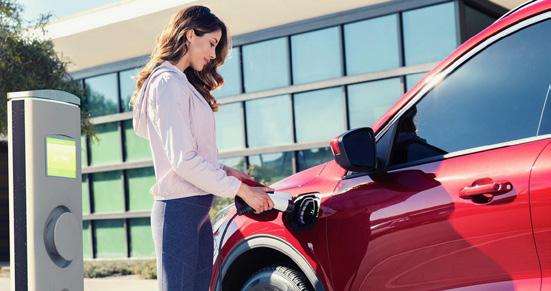

The deal follows Chris Wenzlick retiring after 20 years of providing vehicle reports and online services through his company Lemoncheck.
Mike Harvey
Autocheck, co-founded by Mike Harvey and Andrew Connell, is an online vehicle background report provider and appointed Waka Kotahi agent.

The takeover means Lemoncheck clients can access Autocheck’s portal for services, such as finding reports and completing change of ownership forms. It can also aid trading, including dealer NZTA services MR13B and MR13C.

“We’re excited to acquire Lemoncheck and its customers,” says Harvey. “Chris Wenzlick has been involved in the online vehicle data space since its inception in New Zealand.

“I had been talking to Chris for a number of years about the potential to acquire and continue the Lemoncheck brand or start something new.
“We decided to start afresh and build a mobile-friendly platform. The space we’re operating in is dominated by one large player, but I felt there was an opportunity for something a bit more userfriendly and up to date.”
Autocheck, which was soft launched in 2021, is now fully operational and “concentrated on growth”.
16 www.autofile.co.nz
news We
Contact: Sarah Jane Weston p: 0800 1 DRIVE (0800 137 483) m: 020 4022 7037 e: hello@drivetext.co.nz TIRED OF WRITING CONTENT FOR YOUR VEHICLE LISTINGS? www.drivetext.co.nz Includes specifications and features for every vehicle Save time and money by automating content
ad spend to make listings work harder
provide an AI-based solution of well-written marketing for your
listings
and make
your
vehicles come alive with emotive content.
Enhance
VIA has been taking a “realpolitik” approach – for example, by not opposing the clean-car policies
Client survey affirms online trend
Buyers are driving the car industry toward an omnichannel sales experience. But what does that mean and why should Kiwi dealers be sitting up and taking notice?
A study came across my desk the other day, which demonstrated brilliantly some findings that support what I’ve been banging on about for the past 12 or so months, and that’s that customers want to take more control of their purchasing journey and traders need to adapt.
I acknowledge the study was undertaken by an international organisation, and involved surveying 3,000 consumers and used-car dealers in the UK. Despite this, some results are just as applicable to our unique market and provide an insight into where traders here need to focus their attention.
The research highlights a strong desire by customers to be able to complete more of the purchasing journey online before even setting foot in showrooms.
It also demonstrates the importance of dealers offering an omnichannel experience by establishing nimble processes and technology for buyers to seamlessly move back and forth between online and face-to-face interactions
with their vendors.
VALUING TRADE-INS
Online trade-in valuation is a fairly new technology in New Zealand just starting to take off.
The industry study showed that 63 per cent of customers are keen to obtain an online valuation on their existing vehicle before visiting a dealership. Furthermore, 84 per cent said they are happy to provide extra information to get a more accurate valuation on their car.
ARRANGING FINANCE
Finance was another area customers said they wanted to be able to manage digitally. Sixtyseven per cent of those surveyed said they would need finance for the next car they purchase.
In New Zealand, however, few dealerships offer the capability to undertake a finance transaction online. This is something our industry needs to rectify to meet demand.

ONLINE SALES
Many dealers here refuse to believe we will ever reach a stage when
customers are buying cars exclusively online. This is despite the substantial increase in such sales we’ve witnessed here in recent months.
The study confirms a shift toward online sales with 25 per cent of customers saying they would buy sight unseen and 18 per cent having already done so.
DIGITAL TOOLS
According to the survey results, customers are looking for an omnichannel purchasing experience. Participants expressed a desire to have access to digital tools when transacting with their dealership.
However, they want it to be seamless. Eighty per cent said that, for example, if they receive an online trade-in valuation, they expect those details to be readily available when they walk into a showroom. They don’t want to have to repeat a transaction in person they’ve already completed online. Similarly, 94 per cent said they expect all their interactions to be consolidated across various dealership departments.
WHAT DEALERS SAY
Interestingly, when it came to traders’ responses to the survey, 83 per cent admitted they had invested in upgrading their website in 2022. Sixty-eight per cent of those said they did so to improve user experience, while 72 per cent acknowledged an omnichannel process would have a positive impact on customer service.
As a whole, the findings in this study support the introduction of client portals on dealership websites. Such technology would facilitate an omnichannel experience by providing customers with visibility of their purchasing journey. It would give them the ability to log in and view each interaction they’ve had with their dealership online and off, and throughout the lifecycle of their vehicle ownership.
As the industry moves closer to a complete online purchase model, it’s vital people are provided with the tools and capabilities to transact in a way that suits them. Dealers need to adapt to this new customercentric world and set themselves up for their digital future or risk being left in the dark ages.
Survey: Cox Automotive, Europe. March 2023

www.autofile.co.nz 17 (09) 887 1822 info@adtorqueedge.com adtorqueedge.co.nz ONE LOGIN WE INTEGRATE WITH ALL THE MAJOR AUTO TECH PROVIDERS ASK ABOUT A CUSTOM SOLUTION FOR YOUR BUSINESS JOHN@ABCMOTORS ADTORQUE EDGE ADTORQUE EDGE
TODD FULLER General manager, New Zealand AdTorque Edge
The month that was... May
May 18, 1998
Budget bonanza for importers
The government’s decision to immediately abolish tariffs was the lifeline needed by the car industry for sales to pick up.
Principal measures announced by Deputy Prime Minister Winston Peters during the previous week’s budget also included duty rebates on all unsold and unregistered vehicles imported, a $10.125 million payout to the four remaining assemblers and removing the ban on parallel importing goods protected by copyright.
Applause for the decision on tariffs came from nearly all quarters and the only ones to lose appeared to be component manufacturers.
Some distributors, including Toyota, Ford, Mazda Holden and Volvo, responded to the announcements with immediate cuts in new-vehicle prices. One industry observer told Autofile the biggest winners of the tariff abolition would be distributors that didn’t source cars duty-free from Australia.

Companies sourcing from Australia and Japan would use price advantages to be gained on Japanese-sourced vehicles to offset losses brought about by reducing prices on stock on which no duty had previously been paid.

May 18, 2007
Turners’ first quarter down 59%
Turners Auctions announced a 59 per cent decrease in first-quarter earnings while publicising a potential fraud that could cost it more than $1 million.
At Turners’ annual meeting, chairman Michael Dossor told shareholders that the majority of the 59 per cent first-quarter decline stemmed from a 1,000unit reduction in vehicles sold for importers amid a one per cent drop in 2007’s registrations of used imports compared to 2006.


“About 60 per cent of this reduction arose from just two of our principal suppliers, which went into receivership during 2006,” he said.
As for the potential fraud, Dossor explained the case involved “a past employee who worked for the company for a number of years” and it appeared the amount involved was in excess of $1m.
He added: “Because the matter still requires considerable investigation and is otherwise subjudice, I’m unable to comment any further at this time.”
In his report into 2006, Dossor stated it was a difficult year for the industry and Turners Auctions. “We’re looking at supply channels to see if we can replace lost volumes and will continue to build on auctions that we already have – in essence, to do better with what we can get.”
May 13, 2005 More guilty pleas to fraud

A man pleaded guilty to dozens more counts of fraud in Christchurch District Court. He had formerly pleaded the same way to 43 other charges, although he disputed the total sum of $779,000 that was estimated at the time.
Forty-seven more charges were laid as more of his victims realised they had been ripped off, bringing the total to $1.5 million.
His most recent plea related to 30 of those charges. No pleas were entered for 17 more and it was possible that those would be withdrawn. They related to events dating as far back as 2003.
The man, who was registered as a motor-vehicle trader until March 2005, committed his crimes by offering cars for sale, taking deposits and then using plausible excuses to delay deliveries indefinitely. Some customers were forced to accept inferior models and others received their deposits back.
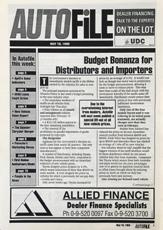
He was remanded in custody for sentencing on May 20, 2005. His lawyer indicted there was little chance of any reparation being paid to his victims.
There was plenty of interest in the case among members of the car industry, with many feeling he had shown it was far too easy to register as a dealer under the Motor Vehicle Sales Act.
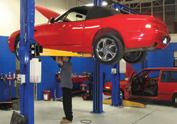
May 8, 2008 Trading, exhaust emissions separate
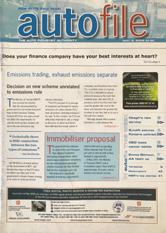
The Ministry of Transport (MoT) assured industry that the announcement by government to not include transport fuels in the emissions trading scheme (ETS) for two years wouldn’t affect requirements for vehicles entering New Zealand as set out in the new emissions rule.
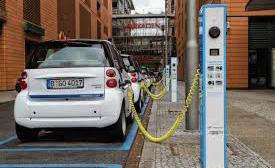
Iain McGlinchy, principal adviser on the environment at MoT, said the decision taken on the ETS didn’t affect any other part of the government’s climate-change strategy or its work on reducing harmful exhaust emissions.
The ETS was part of a package of measures put forward to reduce emissions of carbon dioxide (CO2) from all sectors, including transport.
“In this context, the ETS was effectively intended to add a charge to the price of petrol and diesel that reflected how much carbon it contained and, therefore, how much CO2 is emitted when burned,” he explained.
“The ETS is intended to reduce emissions because the more fuel a vehicle uses, the more CO2 it produces.”
18 www.autofile.co.nz looking back Don’t go searching for news. Let the news come to you. Subscribe now to for twice-weekly updates www.autofile.co.nz/subscribe INSIGHT
Flipping the narrative on harm

There are several common arguments against the uptake of electric vehicles (EVs) and the first one I see is related to safety.
There has been significant recognition recently about the harm being caused on our roads by the proliferation of larger vehicles.
While it’s true that larger vehicles better protect their occupants in a crash, it is zero-sum safety because that enhanced protection also results in increased harm to everyone else involved in the accident, as well as increased harm from noxious emissions in the case of vehicles with internal combustion engines.
The increased harm that comes from bigger vehicles is especially egregious for pedestrians, cyclists and those in small vehicles.
The challenge for EVs, as the argument goes, is that batteries are heavy, which in turn ensures the vehicles are heavy. This then leads to all the risks related to safety as outlined above.
The other argument I often hear against switching to electric cars is the resource needs. EVs have batteries and most are made of materials that need to be mined, often in places with dubious employment and environmental protection policies.
The necessary increase in the production of these materials that would be required to replace the global fleet with EVs would be huge, potentially leading to environmental, political and humanitarian crises.
Both of these concerns are very valid, but the problem doesn’t
necessarily rest with EVs in themselves.
The issue is our desire for big vehicles and the framing of our priorities that make big vehicles look positive.
The problem is that we know change needs to occur, but we insist that it must happen around our preferences.
KIT WILKERSON Head of policy and strategy kit@via.org.nz
Manufacturers like to sell big vehicles because they can make more money on them. They want our cars of the future, our EVs, to be even bigger and more profitable.
Unless necessary for a specific function, large EVs aren’t necessary or optimal. We should be looking at those that are as small and light as possible.
A 1,000kg EV takes one-third as
vehicle does and not the harm it prevents.
To illustrate this, imagine if we rated a vehicle’s emissions by how well it protects its occupants from air pollution. Absurd? Yeah.
The reason we allow this thinking when it comes to crashes is because we’ve been programmed by advertising and a steady narrative to look at the issue this way. It helps sell cars.
If we were to flip the narrative and rate modes of transport by the harm they cause, walking would be the safest followed by cycling, and then other forms of small and efficient vehicles. The least-safe cars would be the massive vehicles that are killing so many people.
work and home. If we focused on those trips and found a way to replace them with small, efficient electric cars, even if the owners had utes on their driveways for use on weekends, it would result in a significant decrease in greenhouse gas emissions and energy demands on our transport system.
Instead, we continue to glorify large vehicles that are counterproductive in every way to our goals. In fact, the government incentivises them in the very programmes it implements to reduce the negative externalities that big vehicles exacerbate.
be significantly lighter and contain much less quantities of those rare materials.
Of course, suggesting cars should get smaller always gets the same response, “but safety…” and “but my boat…”
Lighter vehicles do fare poorly in crashes with more massive vehicles because you can’t beat physics.
Anyone who regularly reads my articles knows my stance on small vehicles. Safety, in my opinion, should be a rating of harm a
Returning to the issue of pulling a boat. This concern is correct. While one could likely put a paddle boat or surfboard on a small EV, no one will be pulling a big fishing vessel in this way.
However, I would argue that isn’t really the change we’re looking for. The vast majority of cars on the road have one occupant and many of those are for simple commutes to or from
For instance, the clean car standard provides a bigger credit for a 3,000kg EV than one weighing 1,000kg regardless of the workload or its passengers. This is the case even though the heavier EV requires more energy to drive and resources to build. Similarly, light vehicles, which fare less well in crashes with heavier vehicles, are continually under risk of being removed from eligibility if they drop to below three stars in crashworthiness when compared to those same big
Personally, I think we should be looking at allowing some of the interesting heavy quadricycles that established and start-up EV manufacturers are exploring, such as the utility-focused electric XBUS. I can envision it being wellreceived by tradies and farmers, especially with its use-specific modular design and swappable batteries.

www.autofile.co.nz 19 tech report
Advise • Advocate • Connect www.via.org.nz Imported Motor Vehicle Industry Association Advocate Advise Connect
The multi-purpose German-made XBUS
Industry movers
MICHAEL FILAZZOLA is Stellantis Australia’s new managing director overseeing Jeep, Alfa Romeo, Fiat, Fiat Professional and Abarth.

He has replaced Kevin Flynn, who has retired after being responsible for business operations and performance of the company’s brands here and across the Tasman.

Filazzola, pictured, has worked in the industry for more than 28 years in Australia, China and south-east Asia. He has senior experience in sales, after-sales, customer experience, purchasing and product development at General Motors, Holden Australia and, most recently, Bapcor.
SIMON EVANS has been appointed as the new brand manager for McLaren Auckland based at its showroom in Grey Lynn.
He joined the Giltrap Group as a salesman in 2010 and also became a sales consultant for Giltrap Porsche 11 years later. Evans has been a professional driver for Smeg Racing since January 2014 and a driving instructor for Downforce Events since 2010.
AARON UNDERDOWN has been appointed company secretary of Geneva Finance.
He will continue in his role as head of risk and assurance, which he took up in November 2022, and reports to the Geneva board’s audit and risk committee. Underdown has more than 20 years’ risk and governance experience. Before joining Geneva, he was head of credit inspection at the Bank of South Pacific.

JENNI RYAN has taken on the newly created role of chief marketing officer at the AA to focus on members, brand and communication.


Ryan is an experienced executive with four years as the CEO of the Skin Institute Group, and a decade working at The Warehouse Group focused on brand and marketing, including some time as chief customer officer.

She joins the AA this month following an interim role as My Food Bag’s chief customer officer.
ANGUS GUERIN will become chief financial officer of NZ Automotive Investments on June 26.
Guerin, pictured, will join the parent company of 2 Cheap Cars after spending a year in the same position at ArchiPro, an online architecture, design and construction platform.
Before that, he spent more than six years with British American Tobacco culminating in his role as director of finance for New Zealand. Guerin, who is replacing Haydn Marks, also has experience here and abroad with multi-national companies, such as Fonterra, Wyndham Exchange and Rentals and Treasury Wines.
ATSUSHI OSAKI has been promoted to chief executive officer and president of Subaru as the marque seeks to accelerate its push into the electric-car market.
He had been executive vice-president since 2019 before also taking on the role of head of the manufacturing division in 2021.
Delight as franchise secures third victory
Farmer Audi has been named dealer of the year for the third time in four years at the Audi Excellence Awards.
The dealership in Mount Maunganui scooped six other trophies at the ceremony held in Christchurch.
Its other winners included service adviser Chris Thompson, service manager Jeff Price and business manager Ashley Turner.
Shaun Marburg was top metropolitan sales specialist, Blair Woolford won the used-car sales manager section and Mitchell Robertson shared the award for parts manager with Eelco Witberg, of Continental Cars in Auckland.
“We are incredibly satisfied with such a successful result,” says Woolford, who is also dealer principal at Farmer Audi. “We’re thrilled some newer staff won awards and winning dealer of the year is a testament to the team’s hard work.”
Giltrap Audi won three awards. Cameron Gemmell was the Auckland sales specialist of 2022, Isaac Litchfield was top technician and the business had the best marketing team.
Michael Pointon, of Armstrong Prestige in Wellington, won the new-car sales manager award, and Craig Purves, of Robertson Prestige in Palmerston North, took out the title for provincial sales specialist.

The apprentice of the year was Jackson Taylor, of Archibalds Audi in Christchurch, and Glen Cameron, of Ebbett Audi, Hamilton, won the warranty adviser award.
Dean Sheed, Audi NZ’s general manager, says: “Our awards programme rewards those who deliver outstanding results across metrics we apply from customer service, technical and marketing right through to sales results.”
Organisation expands
The Financial Services Federation (FSF) has boosted its team to the equivalent of 4.6 fulltime staff.
Katharine McGhie has taken on the new role of business development manager and is responsible for building on its steady membership growth.
Executive director Lyn McMorran says: “After the uncertainty of the past few years, organisations are looking to the FSF as a home to ensure they feel informed, connected, and part of a leadership body advocating for a fair and healthy non-bank lending sector.
“This new role means we will be able to tap into that potential while allowing our small team to continue providing a fantastic service to current members.”
McGhie, pictured left, has joined the FSF after seven years at BusinessNZ where she was business development and events manager.
In addition to McMorran and McGhie, the team includes office manager Sue Bentley, Hannah McKee, marketing, communications and events manager, and legal and policy manager Katie Rawlinson.
20 www.autofile.co.nz
news TO FEATURE IN INDUSTRY MOVERS EMAIL EDITOR@AUTOFILE.CO.NZ
Staff from Farmer Audi
Good time to scrutinise overheads
Last month my column touched on the impacts that tougher economic times are having on consumers.
It’s obvious some people are facing the strain as increased mortgage rates land and the general costs of living continue to climb.
This month I want to expand on that theme a little more because, as business owners, you need to understand the markets you operate in – and be able to and be ready to adjust to meet the changes.
It seems that hardly a day goes by when we as consumers, or perhaps as business operators, are not confronted by price increases somewhere. That could be with the essentials of food and power as we head into winter, or via the slower-burn sectors including rates, insurance and so on.
New Zealand isn’t unique in this regard with similar situations taking place in many countries around the world.
It was, therefore, interesting to read an article in the Australiabased motor-industry journal GoAuto News, which covered the rising costs and impacts on the retail motor industries in the US and across the Tasman.

The headline said it all: “Inflated car prices, bigger loan payments and breakdown costs leaving
financial stress.”
And that surely applies to us in New Zealand as well. Rather than attempt to paraphrase the article,
I have reiterated the opening paragraphs here simply because they might as well have been written for our consumption anyway.
It states: “The Wall Street Journal is reporting that Americans who have signed up for used cars at prices driven up by a lack of lowmileage cars in the market are now struggling to meet their loan repayments.
“As a result of monthly payments being much higher than what they are used to, owners are falling behind on their repayments and defaults on car loans are rapidly rising.
“To make matters worse, because of the shortage of stock, many buyers were forced into much older cars than they would have normally bought. These are now breaking down, leaving owners without a car because they cannot afford the repairs.”
Yes, used-vehicle prices in New Zealand have increased in the face of tighter new product supply
and government policies, such as the clean car discount (CCD) and clean car standard (CCS).
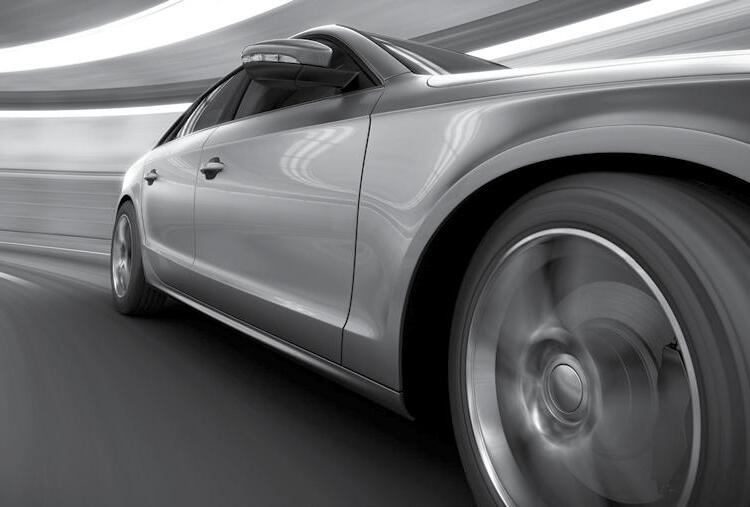

Yes, some consumers have reduced disposable income because of inflationary pressures. And, yes again, spending budgets in some cases might have forced them into older vehicles with a greater risk of them breaking down.
Seemingly reflective of the expected outcomes, it’s interesting to note that the MTA’s mediation helpline team is reporting an increase in calls from owners who are obviously under financial pressure and looking for ways –valid or not – to get out of their cars.
On the flip side, data for the consumers’ price index showed an unpredicted decline – economic forecasting is hard these days – to 6.7 per cent for the March quarter.
So, a glimmer of hope might be on the horizon. But perhaps it’s still timely to recall the old saying about when America catches a cold, we catch pneumonia. In other
words, it would be wise to take stock and scrutinise your business overheads and practices where you are able to.
And you must now do that in the midst of yet more change. We don’t have the luxury of stability in our market with the spectre of more government-led change landing in coming months.
Those changes include the revision of CCD settings effective from July 1. These have not been well-received by many industry participants and representative organisations.
Then there’s the possible imposition of another step upwards in used-vehicle exhaust emissions entry standards later this year, that’s to say Euro 5 compliance for used imports from September 1.
As a final note, used-import dealers who have pay as you go (PAYG) CO2 accounts need to plan for payment in June of their January to May CCS balances.
And from June 1, they will have to meet individual CCS fees upfront if no credit offsets are available as vehicles pass through compliance – in other words no more on account-accrual privileges or “putting it on the tab”, so to speak. So, there’s a bit of a cash-flow double whammy for many PAYG import dealers coming next month.
TONY EVERETT
HELPING DRIVE YOUR BUSINESS The MTA brand is consistently associated with expertise, reliability and trust. Talk with us today about the benefits of MTA membership. mta.org.nz | 0800 00 11 44
Sector manager – dealers, Motor Trade Association
It’s timely to recall the old saying about when America catches a cold, we catch pneumonia
Plug into luxury ‘game changer’
Audi says its latest electrifying offering is set to change the game in the luxury market.
The Q5 50 TFSI e quattro is the first of its new plug-in hybrid (PHEV) range with an internal combustion engine and an electric motor with an “intelligent controller”, enabling it to cover most everyday driving emissions-free.
“The Q5 has been a standardbearer in our premium midsize SUV market for more than 10 years,” says Dean Sheed, general manager of Audi NZ.

“This PHEV variant is the first of our new TFSI e range to land this year and will enable families to make a change towards a more sustainable way of living.”
The new drive concept comprises a four-cylinder, twolitre TFSI turbocharged engine producing 195kW of power and 370Nm of torque.
The synchronous motor has peak electrical output of 105kW and 350Nm of torque. It and the separating clutch are integrated into the seven-speed S-tronic transmission.
The hybrid SUV impresses with



and 450Nm of torque.
According to the standard for PHEVs, fuel consumption ranges from 1.6l/100km, which corresponds to 38gCO2/km. Its real-world WLTP all-electric range is up to 62km.

The lithium-ion battery is under the luggage compartment floor. It stores 14.1kWh of energy with 381 volts. The cooling loop is connected to both the climatecontrol system, and the cooling loop for the electric motor and power electronics.
A heat pump pools the waste heat from the high-voltage components. With 1kW of electrical energy, it can generate up to 3kW of thermal heating output.
The Q5 50 TFSI e marks the first time that Audi’s signature
quattro all-wheel drive (AWD) has been used in combination with an electric motor.

The AWD intelligent control system works predictively, always looking ahead with sensors and using data analysis. When friction between the wheels and road surface changes, power transmission to the rear wheels is deactivated and AWD is also turned off when not needed.
Quiet and with zero local emissions when in full electric mode, the idea is for owners to do the lion’s share of their daily motoring electrically.
The predictive efficiency assistant (PEA) uses route data from the navigation database and chooses between freewheeling with the engine switched off and coasting recuperation – that’s to say, the recovery of kinetic energy and its conversion into electrical energy.
When adaptive cruise control (ACC) is active, the PEA supports the person behind the wheel by automatically braking and accelerating. If driving without ACC, however, a haptic signal from


the active accelerator pedal and visual signal in the head-up display advise the driver.

Hybrid mode is activated automatically with route guidance in the navigation system. In this mode, the battery charge is optimally distributed during the journey to reduce fuel consumption with primarily electric driving in urban areas.
If route guidance is active in the MMI navigation system, the predictive operating strategy attempts to drive the final urban segment fully electrical and arrive at the destination with the drive battery nearly empty.
Audi’s Q5 50 TFSI e offers a generous list of standard equipment. This includes S Line styling, LED headlights, sport front seats, three-zone automatic climate control, convenience key, and 20-inch alloys with five arms.
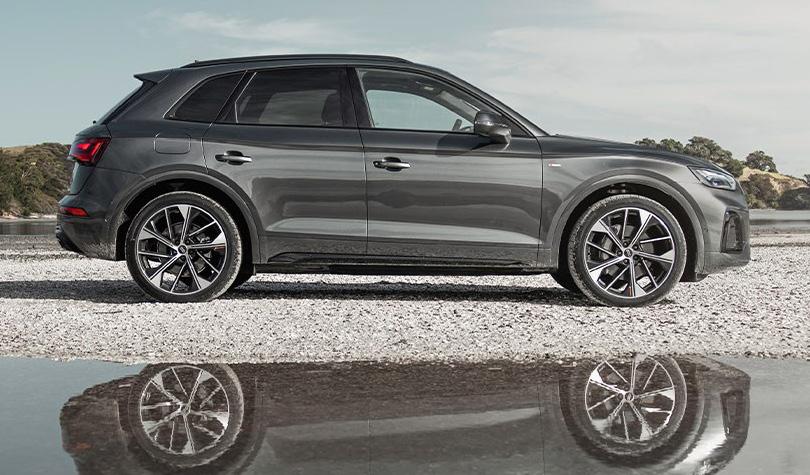
The myAudi app allows customers to check the battery and range status, start the charging process, and view charge and consumption statistics.
The compact charging system comes as standard, plus a modethree cable with a type-two plug for use at public-charging stations.
Audi will contribute up to $1,750, including GST, towards home installation to anyone who buys a new e-tron or Q5 50 TFSI e from an approved dealership. The PHEV is priced from $114,990, including GST plus on-road costs.
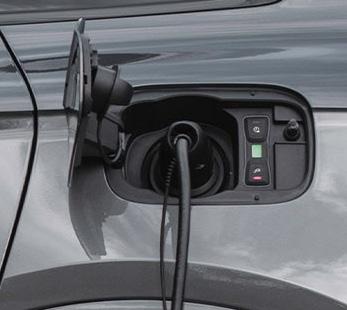
22 www.autofile.co.nz
To advertise here, contact: advertising@autofile.co.nz or ph 021 455 775
NOW Automotive excellence since 1993. Your o cial Audi, Porsche, Jaguar, Land Rover and Volvo dealer Wellington 66 Cambridge Terrace, Te Aro, Wellington | 04 887 1306
VEHICLES WANTED DEALERS BUYING
new cars
The Q5 50 TFSI e quattro is the first Audi in its new PHEV range with a “intelligent controller”
The SUV boasts S Line styling
Bigger and better performance
The first factory-built righthand-drive (RHD) Corvette Z06 to come down under has been revealed.
The new Z06 is indicative of what customers in New Zealand and Australia can expect from the upcoming 2024 model, which GM Specialty Vehicles (GMSV) will be offering in 3LZ trim as standard.
This includes shift paddles made from carbon fibre, sueded microfibre on the upper interior trim, leather-wrapped interior door panels and instrument panels, and GT2 bucket seats with napa leather upholstery.
Greg Rowe, director of GMSV, adds: “Our show car features the Z07 performance package, which makes it more eye-catching and enhances performance.
“That’s thanks to larger brakes with carbon-ceramic rotors, carbon-fibre aerodynamic
elements, unique suspension tuning, ultra-performance tyres and optional carbon-fibre wheels.”
The Corvette Z06 features an allnew naturally aspirated LT6 5.5-litre DOHC V8 with an all-new flat-plane crankshaft design, which gives it a signature growl.
It hits a redline of 8,600rpm, which is 2,000rpm higher than the Stingray. And with a balanced mid-engine design, more of its impressive power is directed to the rear wheels where it matters most.
The engine, which can reach 96.6kph from standstill in 2.6 seconds, is mated to an eightspeed dual-clutch transmission and
Zooming to party
Alimited-run 20th Anniversary Edition Mazda6 has been released in New Zealand.
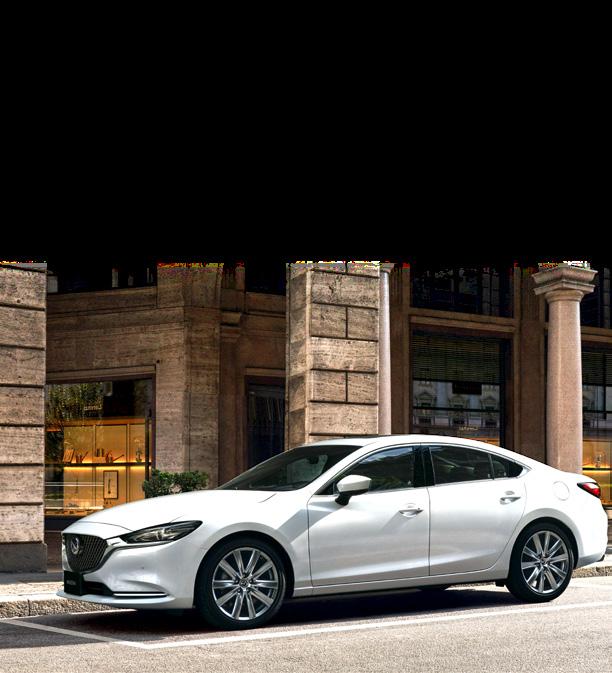
The 2.5-litre turbo engine has been refined with power output lifting to 173kW at 4,250pm. Peak torque stays at 420Nm at 2,000rpm, but torque at 4,250rpm is up by 8Nm.
The Skyactiv-Drive six-speed transmission has been updated to provide a more direct upshift response, while the reactive force of the accelerator pedal has been boosted.
Features include a high-gloss silver for the aluminium wheels and grille mesh.
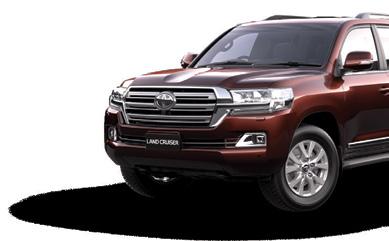

Finishing these elements in the same colour give the entire exterior a “luxurious look”.
Inside, a tan colour palette accentuates the cabin, including high-quality faux suede and nappa leather. The front seats’ headrests are embossed with the model’s logo.
David Hodge, managing director of Mazda NZ, says: “This 20th Anniversary Edition is a special nod to customers who share our passion for driving for the fun of it.”
It’s available at $60,990 for the sedan and $61,990 for the wagon. Prices include GST and exclude on-roads.
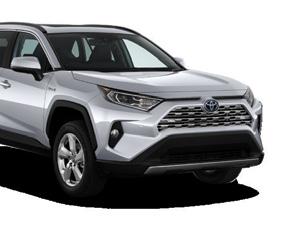
boasts activehandling stability control with traction control.
The car’s enhanced track performance ability is matched with greater braking capability thanks to larger 14.6-inch diameter front and 15-inch diameter rear Brembo rotors. It’s capable of 1.22g on the skid pad.
The Z06 has six-piston front callipers compared to four-piston callipers on the Stingray.
The largest wheels ever available on a production Corvette – 20-inch forged aluminium “spider” wheels
at the front and 21-inch at the rear – provide surefooted grip to get power to the ground.
Inside the cabin, a technology laden and driver-focused cockpit relays all vehicle-related information quickly and concisely.

No specific timeframe has yet been revealed for the arrival in New Zealand of the 2024 model-year Z06. In the US, the current coupe is priced from the equivalent of about NZ$193,500 in 3LZ trim.
Toyota SUVs & Utes
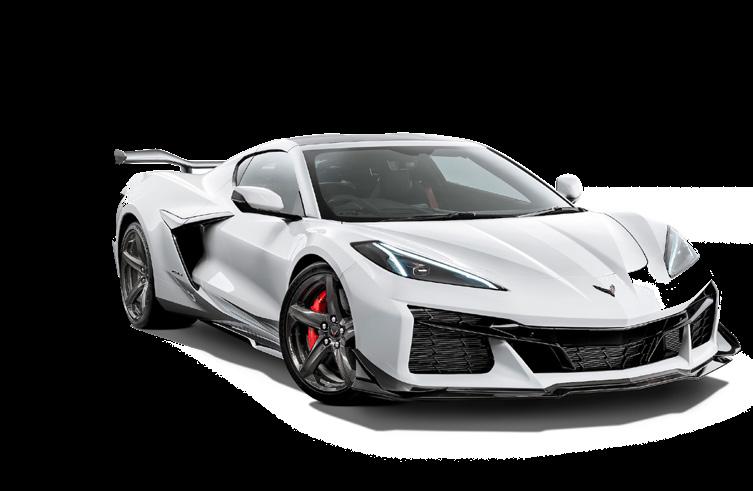
www.autofile.co.nz 23
P. 0274 333 303 | E. pcurin@milesgroup.co.nz ooking to buy late model NZ NEW cars and commercials. Contact Paul Curin. VEHICLES WANTED P. 0274 333 303 | E. pcurin@milesgroup.co.nz Looking to buy late model NZ NEW cars and commercials. Contact Paul Curin. ANTED
P. 0274 333 303 | E. pcurin@milesgroup.co.nz H ilux • L and Cruiser • P rado Looking to buy late model NZ NEW cars and commercials. Contact Paul Curin. VEHICLES WANTED Hilux • Land Cruiser • RAV4 • Prado
new cars
The interior of the right-hand-drive Corvette Z06
Breaking back no ‘roadblock’
It has been a long, and sometimes painful, journey for Chelsea Herbert, who started racing at seven and has never looked back.
The 24-year-old was the first woman to ever win an NZ V8s race before pulling together financial backing to complete a season in the Castrol Toyota Racing Series (TRS).
In addition, she has run in the Toyota 86 Championship, tested for the global Formula W and most recently has been part of The Heart of Racing team initiative managed by International Motorsport.
“For me, it means something a little bit more than just racing and having fun,” says Herbert.
“You’re not just racing for yourself. You have your marketing and you can help businesses create awareness, but ultimately you’re not helping sick kids. This season we were, so that’s pretty special.”
In 2020, Herbert’s launch into TRS came to an abrupt halt when she had a major accident at Teretonga Park Raceway near Invercargill that left her with spinal injuries.

She suffered two compression fractures to her T11 and T12 vertebrae but, remarkably, the Aucklander says the crash made her stronger and more focused.
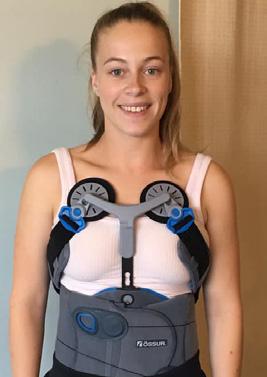
“The accident was unfortunate, but it has had an overall positive impact on me as a driver. I’m even more driven to prove to myself that I can do better and that I can come back stronger.”
Recovery, though, was a painful and long process. Ultimately, it was Herbert’s passion that got her through rehab. As she says: “Breaking my back was only a hurdle, not a roadblock.”
Determined to continue racing, she first went to her parents. “I sat down with my mum and dad. They said the minute this sport isn’t fun for you anymore, you have to leave because you’ve had a pretty cool journey and you don’t want to
leave the sport in a bad way. They were like don’t ever feel pressure to keep doing it because that’s the journey you think you’re on, you do what you want, you chose your own path. I had to sit back and really consider it.”
It was International Motorsport that brought her back into racing.
Starship because I’ve got arthritis and had it for a long time, and without them [the children’s hospital] I would be very far behind in my journey.”
Through The Heart of Racing team programme, Herbert has sprung back to front-running pace.


A global charity template that links motorsport with worthy causes, the team has supported a range of other top Kiwis, such as Christina Orr-West and recently Rianna O’Meara-Hunt.

Herbert and Orr-West raced together in the South Island
“My biggest push to any female coming through motorsport is yes, you might stand out like a sore thumb at the moment, but you’re doing something pretty awesome. There aren’t many sports you can do that so make the most of the opportunity.”
Herbert’s Toyota 86 Championship marked her return from two years off because of the spinal injury and Covid-19. She improved as the season went on in an ultra-competitive field, but says it was “rough”.
The 86 coupes are difficult to drive at maximum pace and reward an approach based on controlled aggression.
“I was really stoked to get back into the car and to have The Heart of Racing backing me was a dream. I think I went in with high expectations from being a top-five competitor in a lot of the classes I’ve competed in and thought that’s where I’d be.
“It was quite a humbling season but by the final round I’d really clicked with the car and was inside the top 10, making moves and passing cars.”
Herbert hopes to get another season in the Toyota 86, her first step being to gather financial backing.
“It’s hard trying to find sponsorship, not being family-funded. It does bring some extra stress and pressure in the off-season.
“It was looking a bit hairy scary there for a while, but they got me back into the sport. They picked me up and treated me like I’d never stopped racing and put me into an awesome opportunity.
“For me, I spent a lot of time at
Endurance Race Series, sharing an Aston Martin Vantage GT4.
Although she tested for the allfemale Formula W, Herbert insists she prefers “open” competition. “When I put on my helmet, I’m the same as anyone else out there.”
The point, she says, is that it’s not about being a woman in a maledominated sport, “it’s about being another competitor within it”.
“I never want to be singled out as being a girl because what’s the point? I’m racing in a mixed-gender sport because that’s where I want to be.
“I just need to sit down with International Motorsport and see what the opportunities are and make the most of what we can within that team. I really clicked with them and enjoyed running with them, so I want to keep that relationship alive. I don’t have any solid plans. My fate is in other people’s hands.”
In the end, Herbert sums up the harsh realities of motorsport and why every win should be celebrated. “There’s usually only one winner and everyone else is packing a sad.”
24 www.autofile.co.nz motorsport
Chelsea Herbert with her The Heart of Racing Aston Martin GT4
Herbert’s TRS car before and after her crash in 2020 and the body brace she had to wear
Paddon claims 10th Otago Rally

Hayden Paddon was in his element at the 2023 Winmax Brakes Rally Otago, winning every stage on his way to a commanding victory.
Driving Hyundai New Zealand’s i20 N Rally2 for the first time this year, he dominated the first day and then extended his overnight lead on each stage to conclude the rally with a winning margin of more than four minutes.
In the stages south of Dunedin, Paddon and co-driver John Kennard were again untouchable, continuing to show why the former is the country’s greatest rally driver.
He set several stage records and beat his previous best Kuri Bush stage time by five tenths of a second.
Behind him was the Holden Barina AP4 of Ari Pettigrew, who was best of the rest for most of the
weekend. He took second place by more than 30 seconds from multiple NZRC champion Ben Hunt.
Hunt’s goal on day two was to catch Pettigrew after a few driving mistakes on the first day, but Pettigrew showed class beyond his years to hold off the fast-charging Skoda driver.
Raana Horan finished fourth
in his Skoda Fabia Rally2 evo, a further minute back from the final podium place, while fifth place went to Emma Gilmour in her debut run of the Citroen C3 R5. Following Gilmour were two AP4s – Josh Marston in his Barina and Robbie Stokes in his Ford Fiesta. Todd Bawden was seventh after the first day, but he hit a rock on the second day’s opening stage.
New generation takes control of series
The pairing of Robbie Stokes and Dave Neill won the opening round of the 2023 Mainland Rally Championship, which was run on the first day of the Otago Rally.


The event was hard-fought with a close battle at the top between Stokes in his Ford Fiesta AP4, and rivals Josh Marston and Andrew Graves in their Holden Barina AP4.
Third home were Marcus van Klink and Toby Marsh, whose Mazda RX-8 came in ahead of the Ford Escort RS1800 of Deane Buist and Karl Celeste.
“I didn’t know what the times were, but we’re just enjoying
ourselves,” says Stokes, who is the son of former New Zealand Rally champion Brian.
“We have a completely rebuilt car [from last season] and a lot
of niggly things we need to get around, but I’m happy with the day.”
Jonty Brenssell and Ben Trevelyan took the early lead in their Mitsubishi Lancer Evo,
winning the opening 21.6km Ridge Road special stage one just north of Oamaru soon after sunrise on April 1.
Their rally finished during the second special stage after an off-road excursion, with Stokes winning the next four stages from Marston with Van Klink, Buist and Mike Tall in his Mitsubishi Mirage all keeping in touch.
Heading into the iconic Danseys Pass stage, Stokes had a 9.5-second lead over Marston, who went about taking nearly 15 seconds off him and secured the lead going into the last two shorter special stages. Stokes eventually won by 20.5 seconds.
www.autofile.co.nz 25
09 966 1779 www.jevic.com S P E C I A L I S T S I N PRE‑SHIPMENT INSPECTIONS MPI biosecurity inspections Biosecurity decontamination Heat treatment Odometer verifications Pre-export appraisals NZTA border inspections ? Lost documentation reports
motorsport
Former WRC driver Mikko Hirvonen comfortably won the Otago International Classic Rally
Hayden Paddon was unchallenged for the lead of Rally Otago
Photos: Peter Whitten
Robbie Stokes at the Mainland Rally Championship
Photo: Terry Marshall
Buyer’s remorse no reason to reject car says dealer after repairing faults
Background

Helen Saxelby purchased a 2017 Nissan Note e-Power Nismo for $20,300 from Olgo Motors Rolleston Ltd on August 31, 2022, for her son David, who also attended the hearing and gave evidence.

David Saxelby had traded in his car as part of the transaction. The Nissan’s odometer read 69,400km at the time of purchase and the vehicle had only been driven for 1,100km before it was rejected.
Mrs Saxelby alleged the car wasn’t of acceptable quality from the time of purchase due to a number of problems that had become apparent over time, which led to her decision to reject it. She also claimed the Nissan was unsafe.
Olgo Motors said she wasn’t entitled to reject the vehicle under the CGA because it had repaired the car’s faults. The trader believed the Saxelbys had experienced buyers’ remorse.
The case
David Saxelby owned a Toyota Prius that was due for major repairs, so he decided to buy a replacement low-kilometre used vehicle with help from his mother.
When he collected the Note, he noticed rust in the front-left sill. He raised his concerns with a salesman from Olgo Motors, who promised to look into the issue further. The staff member described the problem as “surface rust”.
Over one weekend, David Saxelby noticed that the car’s fuel economy was “poor” when he was driving it. He discovered the vehicle had a filthy or clogged air filter despite having been told by the salesman that the Nissan had just been serviced.
On September 5, 2022, he rejected the vehicle on the grounds of undisclosed rust damage. Olgo Motors said if there was a fault with the car, it would fix it.
Three days later, the buyer
arranged for the Nissan to be inspected, and he was advised it had structural damage and shouldn’t have been issued with a WOF. He then returned the car to the trader.
Olgo Motors didn’t accept the buyers’ rejection of the vehicle, but agreed to store it pending resolution of their application to the tribunal. It offered to repair the faults, but David Saxelby refused the offer.
Mrs Saxelby also sought to reject the vehicle. She wanted the traded-in Prius returned and to be refunded the cash portion of the Nissan’s purchase price.
The finding
The adjudicator had to first consider whether the Nissan was of acceptable quality under the terms of the CGA.
This had to be looked at from the point of view of a reasonable consumer who was fully acquainted with the state and condition of the vehicle, including any hidden defects.
Mrs Saxelby listed the following faults with the car: poor fuel economy due to a clogged air filter, which had since been repaired by the trader, structural damage to the left-hand front sill and worn tyres.
The tribunal found the filter was a minor issue that was easily fixed and had since been remedied by the dealer. Likewise, the tyres had passed a WOF and the buyer’s prepurchase inspection.
Therefore, the adjudicator said that both of those matters didn’t breach the CGA’s guarantee of acceptable quality.
However, damage to the car’s sill was a different matter. David Saxelby produced a condition assessment prepared by Canterbury Vehicle Compliance Ltd.
This described structural damage to the left-hand front sill. It was reported that the door was rubbing against the sill where the latter had been pushed up when it was damaged.
Canterbury Vehicle Compliance said there was no record of any sill repair in the system.
At the hearing, the buyer produced photographs of the damaged sill. It was clear from these that there was no gap between it and passenger door.
However, the dented sill didn’t compromise the vehicle’s structural integrity enough to be a safety issue and the damage had not been detected by VINZ during a compliance certification inspection of the Nissan on August 10, 2022.
The trader told the hearing that the dent to the sill had been fixed. It produced a WOF report issued by VTNZ, which was dated October 20.
It showed that the car had passed its inspection in all categories. The dealer also produced pictures of repairs to the sill that had been carried out in-house.
The tribunal considered that the sill damage did breach the CGA’s guarantee of acceptable quality because the car wasn’t as
The case: The purchasers of a 2017 Nissan Note wanted to reject the car because of some minor faults, including damage to its sill. The trader said it had remedied the issues, so they weren’t entitled to reject it under the Consumer Guarantees Act (CGA), and claimed they had buyers’ remorse.
The decision: The adjudicator rejected the application because the problems weren’t of substantial character and had been fixed by the dealer to warrant of fitness (WOF) standards.
At: The Motor Vehicle Disputes Tribunal, Christchurch.
free of minor defects or as durable as a reasonable consumer would consider acceptable.
It concluded that a reasonable consumer would not expect a vehicle of that price, age and mileage to have such damage.
Although the trader had repaired the damaged sill, the adjudicator said it wasn’t for Olgo Motors to dictate terms to Mrs Saxelby, who still wanted to reject the Nissan.
But as the dent to the sill wasn’t of substantial character, she was somewhat limited in remedies available to her under the CGA.
Mrs Saxelby’s only remedy for this damage was to have it repaired by the dealer at its own cost, which had occurred.
While she was critical of Olgo Motors’ actions in repairing the sill without asking her if it should go ahead with the work, she had already chosen to reject the Nissan.
The tribunal was unable to find any basis for Mrs Saxelby to reject the vehicle under the terms of the CGA because the breach wasn’t irremediable or of substantial character.
In addition and prior to lodging her application to reject the car with the tribunal, she had refused to allow the trader to repair the Nissan.
Order
The purchasers’ application to reject the vehicle under the CGA was dismissed by the adjudicator.
disputes
A 2017 Nissan Note e-Power Nismo
26 www.autofile.co.nz
disputes
Vehicle retained by trader for more than one year to remedy problems
Background

Joseph Winiata bought a 2008 Subaru Forester for $14,485 from Nabi Ltd in August 2021.
The vehicle developed a transmission fault on the day of purchase, so the buyer returned it to the dealer for remedial work.
However, the Subaru had still not been repaired by March 2022, so Winiata filed his claim with the tribunal seeking to reject the car under the Consumer Guarantees Act (CGA).
Unfortunately, Winiata passed away in September 2022 so his son, Komene Admore, decided he would resolve the issue on behalf of his late father’s estate.
The case
Admore, who appeared as Winiata’s representative at the hearing, said that he only became aware of the dispute with the trader after his father had died.
As a result, Admore contacted Jamal Sidique, a director of Nabi Ltd, to deal with the matter.
He told the adjudicator that he had spoken with Sidique on several occasions and the latter had confirmed the Subaru had a transmission fault that the trader had agreed to rectify.
However, Admore didn’t know where the vehicle was or whether it had been repaired, but he did know that the Forester was never returned to his father.
Admore also told the hearing that Sidique agreed Nabi Ltd would refund the purchase price to his father’s estate, but it had failed to do so.
Despite receiving a notice of hearing from the tribunal, the trader failed to attend the hearing and provided no evidence or submissions to the adjudicator in support of its position.
The dealer also failed to provide a report to the tribunal as required by schedule one, clause five of the Motor Vehicle Sales Act (MVSA).
Consequently, in the absence of any information from the trader, the adjudicator had to proceed on the basis of the information provided by the buyer and the evidence given by Admore during the hearing.
The finding
An issue that required the tribunal’s consideration in this case was if the Subaru had been of acceptable quality for the purposes of section six of the CGA.
Other matters to be ruled on were if the trader had failed to rectify the car’s defects within a reasonable time and what remedy the buyer was entitled to under the terms of the consumer legislation.
Firstly, section six of the CGA provides that “where goods are supplied to a consumer there is a guarantee that the goods are of acceptable quality”.
Whether a vehicle is of acceptable quality has to be considered from the point of view of a reasonable consumer who is fully acquainted with the state and condition of the vehicle, including any hidden defects.
Although the evidence was unclear as to the precise nature of the Forester’s faults, the adjudicator was satisfied that the car had developed a transmission fault shortly after purchase, which Nabi Ltd had agreed to rectify.
A reasonable consumer who purchased a vehicle of this price, age and mileage would not expect such a fault to occur on the day of purchase.
In addition, the fault meant the car wasn’t of acceptable quality because it wasn’t as free of minor defects as a reasonable consumer would consider acceptable.
The second issue the tribunal considered was whether Nabi Ltd failed to rectify the defects within a reasonable time.
Section 18 of the CGA enables a consumer to reject goods when a supplier has been required to remedy a failure, but has failed to do so within a reasonable time.
In addition to the remedies set out in section 18, the purchaser might obtain from the supplier damages for any loss or damage to the buyer resulting from the failure, other than loss or damage through any reduction in value of the goods that was reasonably foreseeable as liable to result from the failure.
The tribunal found the trader had failed to rectify the Subaru’s defects within a reasonable time.
The car was returned to Nabi Ltd for repairs in August 2021. It hadn’t been remedied by the time the buyer filed his claim in early September 2022. Irrespective of the nature or complexity of any fault the vehicle might have, 13 months was much longer than was reasonable.
The third issue the tribunal had to address was whether the buyer was entitled to a remedy under the CGA.
The relevant options are contained in section 18 of the legislation. It was ruled that
The case: A transmission fault developed in a Subaru Forester as soon was it supplied. The consumer returned it to the dealer on the same day it was purchased. However, 13 months later, the car had still not been returned to the buyer so it was rejected. The trader failed to appear at the hearing.
The decision: The tribunal upheld the rejection of the vehicle. It ordered the dealer to refund the full purchase price and collect its courtesy car.
At: The Motor Vehicle Disputes Tribunal, Auckland.
because the trader had failed to rectify the defects within a reasonable time, the buyer was entitled to reject the vehicle.
Having rejected the car, the purchaser was entitled to a refund of all amounts paid for the Subaru under section 23 of the CGA.
Admore also sought to recover the costs he incurred in attending the hearing as his late father’s representative.
Under schedule one, clause 14 of the MVSA, the tribunal may only award costs to a party to the proceedings.
Admore was not a party to the proceedings, so he wasn’t entitled to recover any costs that he had incurred.
However, the adjudicator ruled the trader had to pay the $50 filing fee that the buyer paid to file the claim. This was because the tribunal is allowed to award costs to one party when the other party fails to attend the hearing without reasonable cause.
Orders
The application to reject the Subaru Forester was allowed.

The trader was ordered to pay $14,535 to Winiata’s estate, care of Rice Craig Barristers & Solicitors.
The dealer was also ordered to contact Admore and make arrangements to immediately collect the Mazda Atenza that it provided to the purchaser as a courtesy car.
www.autofile.co.nz 27
A 2008 Subaru Forester

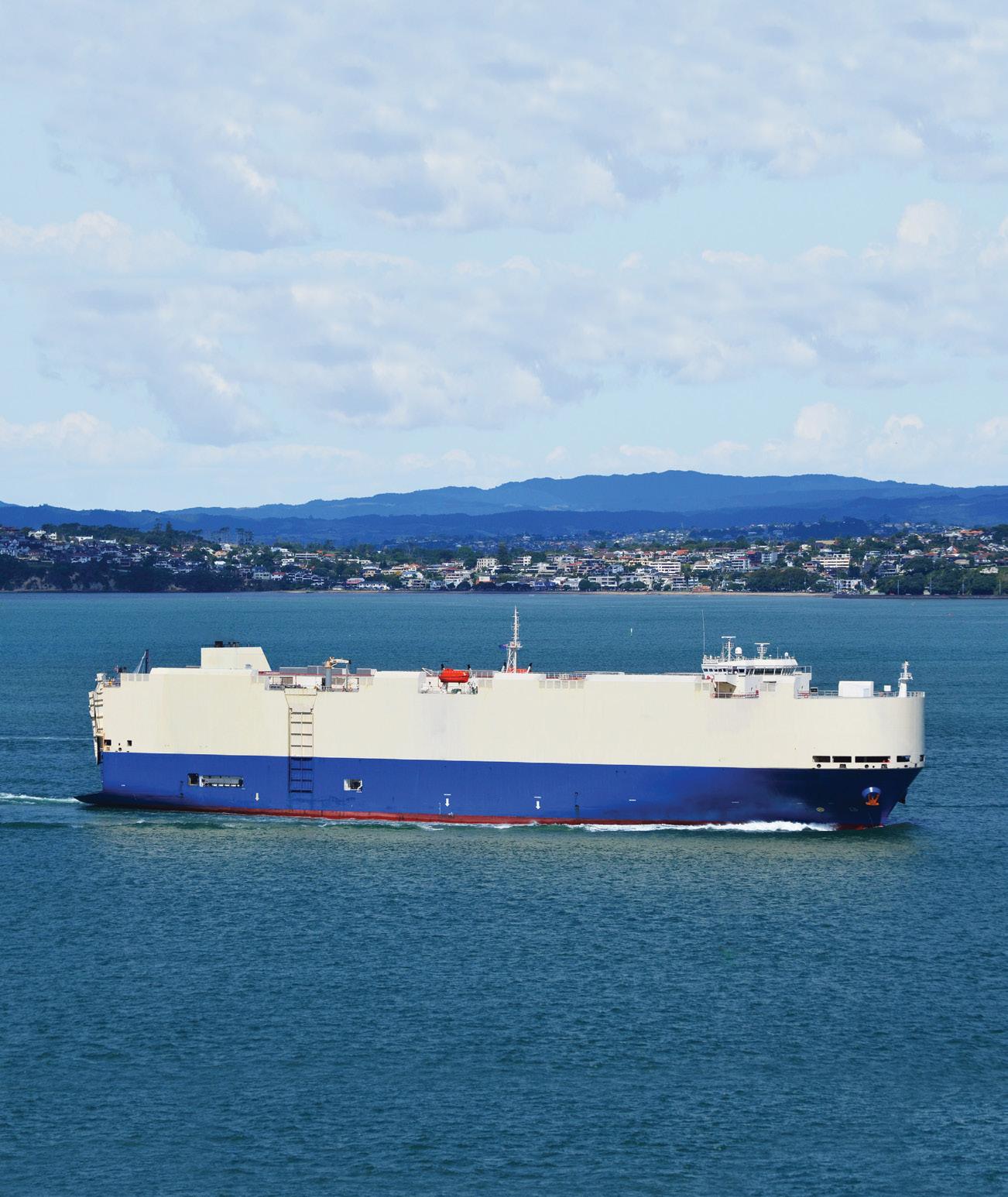


28 www.autofile.co.nz Phone 0800 ARMACUP (0800 276 2287) email Enquiries.NZ@armacup.com www.armacup.com Shipping to Driving the Pacific...
Total new cars
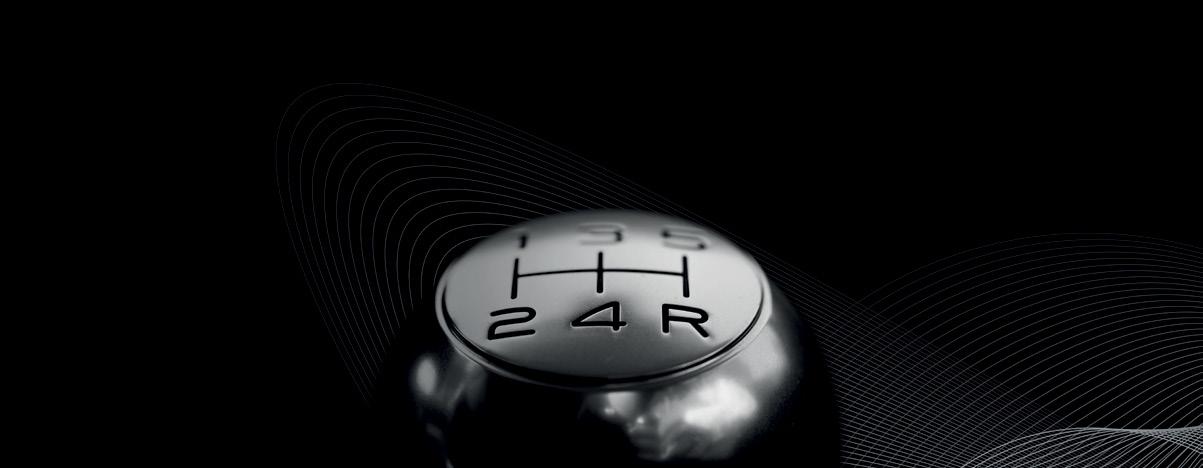
7,061
April 2023

Total imported used cars
7,945

OTHERS (Chatham Islands, overseas, unknown) NORTHLAND NEW: 2022: USED: 2022: BAY OF PLENTY NEW: 2022: USED: 2022: AUCKLAND NEW: 2022: USED: 2022: GISBORNE NEW: 2022: USED: 2022: HAWKE ’S BAY NEW: 2022: USED: 2022: MANAWATU –WHANGANUI NEW: 2022: USED: 2022: WELLINGTON NEW: 2022: USED: 2022: MARLBOROUGH NEW: 2022: USED: 2022: CANTERBURY NEW: 2022: USED: 2022: OTAGO NEW: 2022: USED: 2022: SOUTHLAND WAIKATO NEW: 2022: USED: 2022: TARANAKI NEW: 2022: USED: 2022: NELSON NEW: 2022: USED: 2022: TASMAN NEW: 2022: USED: 2022: WEST COAST NEW: 2022: USED: 2022: 268 302 302 205 11.3% 47.3% 713 1,152 1,000 995 28.7% 15.8% 31 29 22 33 40.9% 12.1% 63 26 70 21 10.0% 23.8% 30 43 57 55 47.4% 21.8% 46 55 76 73 39.5% 24.7% 738 583 1,070 583 31.0% 0.0% 278 168 396 187 29.8% 10.2% 129 115 184 111 29.9% 3.6% 175 177 270 143 35.2% 23.8% 25 46 47 11 46.8% 318.2% 426 353 488 304 12.7% 16.1% 605 626 741 489 18.4% 28.0% 3,282 4,022 3,474 3,063 5.5% 31.3% 139 132 197 135 29.4% 2.2% Whangarei Auckland Hamilton Thames Tauranga Rotorua Gisborne Napier New Plymouth Wanganui Palmerston North Masterton Wellington Nelson Blenheim Greymouth Whangarei Auckland Hamilton Thames Tauranga Rotorua Gisborne Napier New Plymouth Wanganui Palmerston North Masterton Wellington Nelson Blenheim Greymouth Westport Christchurch Timaru Oamaru Dunedin Invercargill Whangarei Auckland Hamilton Thames Tauranga Rotorua Gisborne Napier New Plymouth Wanganui Palmerston North Masterton Wellington Nelson Blenheim Greymouth Whangarei Auckland Hamilton Thames A R OUND T H E COUNT
Y
R
2022: 6,497 22.3%
2022: 8,519 17.1%
FINANCE TO SHIFT Y OUR BUSINESS I N TO TOP GEAR Your Vehicle Import Finance Specialist To find out more visit us at www.blackbirdf і nance.co.nz or call us on 0800 000 999
Imported Passenger Vehicle Sales by Make - April 2023
Imported Passenger Vehicle Sales by Model - April 2023
WHAT DO YOU WANT FROM YOUR VEHICLE SUPPLIER?
30 www.autofile.co.nz
MAKE MODEL APR '23 APR '22 +/- % APR 23 MKT SHARE 2023 YEAR TO DATE 2023 MKT SHARE Toyota Aqua 1,202 1,397 -14.0 15.1% 4,958 15.2% Toyota Prius 834 559 49.2 10.5% 3,170 9.7% Mazda Axela 409 303 35.0 5.1% 1,736 5.3% Toyota Corolla 308 308 0.0 3.9% 1,142 3.5% Nissan Note 300 167 79.6 3.8% 1,046 3.2% Honda Fit 277 205 35.1 3.5% 1,053 3.2% Mazda Demio 239 178 34.3 3.0% 1,036 3.2% Nissan Leaf 202 294 -31.3 2.5% 952 2.9% Subaru Impreza 199 122 63.1 2.5% 815 2.5% Nissan Serena 185 80 131.3 2.3% 777 2.4% Volkswagen Golf 183 158 15.8 2.3% 864 2.7% Mitsubishi Outlander 174 91 91.2 2.2% 720 2.2% Nissan X-Trail 173 122 41.8 2.2% 650 2.0% Suzuki Swift 161 90 78.9 2.0% 657 2.0% Toyota C-HR 160 146 9.6 2.0% 608 1.9% Mazda CX-5 157 201 -21.9 2.0% 685 2.1% Toyota Vitz 124 86 44.2 1.6% 463 1.4% Subaru XV 112 63 77.8 1.4% 473 1.5% Toyota Sai 102 42 142.9 1.3% 443 1.4% Mazda Atenza 85 64 32.8 1.1% 353 1.1% Toyota Camry 77 67 14.9 1.0% 282 0.9% Toyota Wish 76 70 8.6 1.0% 235 0.7% Mazda Premacy 71 70 1.4 0.9% 345 1.1% Honda Vezel 69 55 25.5 0.9% 275 0.8% Volkswagen Polo 51 47 8.5 0.6% 260 0.8% BMW 116i 48 35 37.1 0.6% 200 0.6% Subaru Legacy 45 20 125.0 0.6% 213 0.7% Honda Grace 44 39 12.8 0.6% 179 0.6% Nissan Juke 44 28 57.1 0.6% 234 0.7% Honda Insight 39 30 30.0 0.5% 134 0.4% Mercedes-Benz A180 39 27 44.4 0.5% 139 0.4% Audi A3 38 52 -26.9 0.5% 201 0.6% BMW 320i 38 31 22.6 0.5% 151 0.5% Honda CR-Z 38 29 31.0 0.5% 147 0.5% Toyota 86 37 6 516.7 0.5% 140 0.4% Others 1,605 1,215 32.1 20.2% 6,784 20.9% Total 7,945 6,497 22.3 100.0% 32,520 100.0%
MAKE APR '23 APR '22 +/- % APR '23 MKT SHARE 2023 YEAR TO DATE 2023 MKT SHARE Toyota 3,323 2,908 14.3 41.8% 12,920 39.7% Nissan 1,070 842 27.1 13.5% 4,468 13.7% Mazda 1,041 854 21.9 13.1% 4,440 13.7% Honda 585 444 31.8 7.4% 2,264 7.0% Subaru 444 269 65.1 5.6% 1,878 5.8% Volkswagen 274 230 19.1 3.4% 1,295 4.0% Mitsubishi 244 142 71.8 3.1% 1,015 3.1% Suzuki 215 121 77.7 2.7% 885 2.7% BMW 214 154 39.0 2.7% 936 2.9% Audi 137 131 4.6 1.7% 663 2.0% Mercedes-Benz 122 98 24.5 1.5% 496 1.5% Lexus 82 86 -4.7 1.0% 385 1.2% Ford 42 42 0.0 0.5% 170 0.5% Volvo 19 25 -24.0 0.2% 77 0.2% Land Rover 18 9 100.0 0.2% 58 0.2% Mini 11 11 0.0 0.1% 55 0.2% Jaguar 9 8 12.5 0.1% 36 0.1% Hyundai 8 11 -27.3 0.1% 26 0.1% Chevrolet 7 25 -72.0 0.1% 49 0.2% Dodge 7 14 -50.0 0.1% 31 0.1% Holden 7 9 -22.2 0.1% 27 0.1% Daihatsu 6 2 200.0 0.1% 14 0.0% Porsche 6 8 -25.0 0.1% 42 0.1% Peugeot 5 1 400.0 0.1% 26 0.1% Chrysler 4 1 300.0 0.1% 25 0.1% Jeep 4 7 -42.9 0.1% 26 0.1% BYD 3 0 300.0 0.0% 13 0.0% Kia 3 6 -50.0 0.0% 18 0.1% Rolls-Royce 3 0 300.0 0.0% 6 0.0% Smart 3 4 -25.0 0.0% 15 0.0% Aston Martin 2 1 100.0 0.0% 5 0.0% Cadillac 2 0 200.0 0.0% 6 0.0% Opel 2 0 200.0 0.0% 9 0.0% Pontiac 2 3 -33.3 0.0% 6 0.0% Rover 2 0 200.0 0.0% 4 0.0% Others 19 31 -38.7 0.2% 131 0.4% Total 7,945 6,497 22.3 100.0% 32,520 100.0%
Kiwis aim to buy in budget
New Zealanders intend to buy fewer cars this year than in 2022, according to a Trade Me survey.
Of those who took part, 21 per cent said they are planning to purchase a second-hand vehicle in 2023 compared to 27 per cent last year, while five per cent intend to buy new –down from nine per cent.
Twenty-nine per cent are looking to pay for their next purchase on finance, while 42 per cent are willing to travel further for the right car to stay within budget.
In addition, 32 per cent say their motivation for buying an electric vehicle (EV) or hybrid is that they are more economical to run, 30 per cent say it’s because they are environmentally friendly and 27 per cent cite the high cost of fuel.
Other results of the survey, which collates answers from 2,198 people, include:
32 per cent will consider the type of vehicle, such as make and model, and 13 per cent its age or its condition to stay in budget.
42 per cent plan to buy petrolpowered vehicles, 38 per cent hybrid, 11 per cent electric and eight per cent diesel.
While hybrids and EVs are growing in popularity, “petrol is still winning for now”, say Jeremy Wade and Alan Clark, heads of classifieds at Trade Me.
They add while people are planning to move on vehicle and home purchases, they are willing to compromise to not break the bank.
“Car buyers are compromising
Boost in trade
There were 7,945 used-imported cars registered in April. That was a jump of 22.3 per cent compared to 6,497 in the same month of last year and brought the year-to-date total to 32,520.
Toyota’s Aqua was last month’s most popular model with 1,202 units and the Prius second with 834. Mazda’s Axela was third on 409.
Toyota was April’s top marque with 3,323 registrations.
on the make and model to get what meets their budgets,” they say.
According to Trade Me’s state of the nation report – first reported on by www.autofile.co.nz on April 18 – median prices on Trade Me Motors during the fourth quarter of last year jumped with double-digit increases in most categories. Average prices climbed by 10 per cent to $15,345 for used and $52,990 for new.
Last year’s final quarter saw a
“positive increase” in supply for new cars after manufacturing delays. That said, falling consumer confidence saw demand “tumble” compared to 2021.
For used cars, supply and demand dropped by 16 and 37 per cent respectively. For new, supply climbed by 18 per cent on the back of demand falling by 20 per cent.
It’s not just prices on consumers’ minds, but also who they are buying from with more cars selling the first time they are listed by dealers compared to public-to-public sales. Cars sold after the initial listing period came in at 84 per cent for traders and 61 per cent for private transactions.
As for most popular models by fuel type, petrol was the Holden Commodore, diesel was Toyota’s Hilux, hybrid was the Toyota Aqua and fully electric was Nissan’s Leaf. Growth in demand by fuel type in 2022 compared to the previous year dropped by eight and 10
per cent respectively for diesel and petrol. Increases were seen in fully electrics, hybrids and plug-in hybrids by 53, 30 and 119 per cent respectively.
In Trade Me’s report, Brad Olsen, Infometrics’ principal economist, says the spending crunch is hitting the car market, although regulatory changes are driving a sustained shift in focus for vehicles.
“Recent weather events will provide a short-term boost to used-car purchases with the hunt on for anything that hasn’t been waterlogged,” he says.
“But used cars remain difficult to source and there are stronger incentives that make new cars more attractive than before.
Increasingly, the clean car discount is seeing Kiwis move away from used, large vehicles towards new, small vehicles.
“The focus has also moved to more electric and hybrid vehicles as fuel prices remain high, and as climate change becomes a reason of rising importance in purchasing decisions. Incentives for these vehicles remain persuasive.”
CALL TO ACTION

The Motor Trade Association is set to launch its call to action on May 9. “Driving New Zealand Forward – future-proofing the automotive industry” identifies challenges the sector faces and what the next government should do to address them.
It covers warrants of fitness, the clean-car policies and scrappage, the labour shortage and NZ Immigration’s green list, training and law reforms.

www.autofile.co.nz 31 contact: Taka Arimoto email: arimoto@heiwa-auto.co.jp www.heiwa-auctions.com ü SOLID COMPANY ü QUALITY VEHICLES ü CHOICE & VARIETY OF STOCK ü EXPERIENCED AGENTS ü DEALER ONLY SUPPLIER ü GREAT VALUE FOR MONEY 0 5,000 10,000 15,000 20,000 25,000 Jan Feb Mar Apr May Jun Jul Aug Sep Oct Nov Dec 2019 2020 2021 2022 2023 Used Imported Passenger Registrations - 2019-2023
Profit rises as port volumes drop
Port of Tauranga has reported strong financial results for the first six months of its 2023 financial year.
Net profit came in at $62.7 million for an 11.3 per cent increase on the previous corresponding period, while total cargo decreased by 2.5 per cent to 12.7m tonnes.
The company’s performance was driven by an increase in container volumes and transhipments, as well as the return of cruise ships.
Container volumes increased 2.5 per cent to 637,728 TEUs for the six-month period, with transhipped containers jumping
by 21.7 per cent. There were 701 ship visits, up by 2.5 per cent.
Chief executive Leonard Sampson says intermittent delays and congestion have continued to plague the container terminal with vessels arriving off-schedule.
He notes that some bunching has occurred during the reporting period, which resulted in ships waiting at anchor and surges of volumes putting pressure on terminal capacity and efficiency.
“By reinstating adherence to pro-forma windows, we will be able to accurately predict container volumes and match resources accordingly,” says Sampson. “This
will allow us to deliver improved efficiency and avoid delays for shipping lines and shippers.
“We have been working with other ports to ensure the entire network can get back on time and allow us to better plan capacity.”
Chairwoman Julia Hoare adds: “Shipping schedule unreliability and increased operating costs have been challenges.
“We’ve mitigated impacts of congestion through surcharges to incentivise smooth cargo flows and avoid excess dwell time for containers in the terminal.”
She describes the port’s plans for a berth extension at the
USED IMPORTED PASSENGER VEHICLE ARRIVALS
container terminal as “critical” to the New Zealand’s economy.
“Catastrophic weather events have also demonstrated New Zealand is in dire need of greater resilience and capacity in the supply chain.”
OVERALL TOTAL CLIMBS
There were 8,775 used cars imported last month. That brought the year-to-date total to 32,840, which is up by 9.6 per cent from 29,971 by the same time in 2022. Japan, with 8,608 units, accounted for 98.1 per cent per cent of all used passenger vehicles crossing the border in April.
Used Imported Passenger Vehicles By Country Of Export
32 www.autofile.co.nz Door-to-Door vehicle shipping experts ContaCt us today! To and from Japan, USa, UK, aUSTralia, Singapore, and The pacific Ph +64 9 303 0075 www.mmnz.biz www.mmnz.biz
20,000 19,000 18,000 17,000 16,000 15,000 14,000 13,000 12,000 11,000 10,000 9,000 8,000 7,000 6,000 4,000 JAN FEB MAR APR MAY JUN JUL AUG SEPT OCT NOV DEC 2014 2015 2017 2021 2018 2020 2019 2016 2013 2022 2023
COUNTRY OF EXPORT 2023 2022 2021 JAN ’23 FEB ’23 MAR ’23 APR ’23 APR MKT SHARE % 2023 TOTAL Q1 Q2 Q3 Q4 2022 TOTAL MKT SHARE 2021 TOTAL MKT SHARE Australia 126 83 137 90 1.0% 436 723 639 559 432 2,353 2.6% 3,072 2.4% Great Britain 34 17 25 24 0.3% 100 160 160 69 123 512 0.6% 1,259 1.0% Japan 4,846 7,404 11,225 8,608 98.1% 32,083 20,718 27,387 19,322 20,313 87,740 95.6% 123,508 94.8% Singapore 23 3 24 27 0.3% 77 148 118 77 80 423 0.5% 1,378 1.1% USA 29 19 22 10 0.1% 80 139 122 99 127 487 0.5% 697 0.5% Other countries 24 12 12 16 0.2% 64 84 55 62 49 250 0.3% 403 0.3% Total 5,082 7,538 11,445 8,775 100.0% 32,840 21,972 28,481 20,188 21,124 91,765 100.0% 130,317 100.0%
Agency ‘will work with industry’
Waka Kotahi says it’s confident it can make the necessary changes to its systems for the overhauled clean car discount (CCD) to be launched as planned in July.
Adjustments to the feebates scheme were announced by Michael Wood, Minister of Transport, this month.

However, the revamp has attracted criticism from the automotive industry. This includes the roll-out only being two months after it was unveiled on May 2.
“Waka Kotahi is working on implementation of the July 1 changes,” a spokesman told Autofile.
“This includes updating and supporting our systems and tools, including our information sources – and the Fuelsaver and Rightcar tools that importers and dealers use to obtain CCD fee and rebate estimates.

“Our priority is to make it as easy as possible for the vehicle industry and purchasers to understand the changes and impacts.”
Waka Kotahi is also aiming to provide dealers with calculation tools between mid and late May so they can establish what discounts and penalties under the feebate scheme will be from July 1.
In the run-up to that date,
calculations can be made for future imports on a per-gram basis using the agency’s existing tables.
Waka Kotahi adds it will “continue to work closely with industry in coming months” to ensure it has the information and support it will need to ensure public awareness of the changes.
“Systems that apply fees and deliver the online rebate applications, and back-end assessment and payment processes, will be updated to apply the new rates for vehicles registered from July 1.”
The changes to the CCD include the rebates limit for all imported
light vehicles at the time of first registration in New Zealand dropping from 146g of carbon dioxide (CO2) per kilometre to 100g.
Fees will also apply to vehicles with emissions of 150gCO2/km or more, rather than starting at the current level of 192g.
TRADE FALLS BACK
Dealers sold 13,204 second-hand cars to public buyers during April. That was down from 14,801, or by 10.8 per cent, when compared to the same month 2022.


There were 11,393 trade-ins last month, which represented an increase of one per cent.

www.autofile.co.nz 33
SECONDHAND CAR SALES - April 2023 DEALER TO PUBLIC PUBLIC TO PUBLIC PUBLIC TO DEALER REGION APR '23 APR 22 +/- % MARKET SHARE APR '23 APR '22 +/- % APR '23 APR '22 +/- % Northland 432 513 -15.8 3.27 1,618 1,814 -10.8 168 190 -11.6 Auckland 4,834 5,223 -7.4 36.61 13,134 12,104 8.5 5,013 4,789 4.7 Waikato 1,317 1,432 -8.0 9.97 3,564 3,867 -7.8 1,035 1,040 -0.5 Bay of Plenty 794 1,026 -22.6 6.01 2,633 2,719 -3.2 556 589 -5.6 Gisborne 121 142 -14.8 0.92 328 375 -12.5 36 57 -36.8 Hawke’s Bay 554 513 8.0 4.20 1,341 1,361 -1.5 338 349 -3.2 Taranaki 297 393 -24.4 2.25 931 1,049 -11.2 181 196 -7.7 Manawatu-Whanganui 647 839 -22.9 4.90 1,834 2,053 -10.7 675 628 7.5 Wellington 1,111 1,387 -19.9 8.41 2,835 3,234 -12.3 852 995 -14.4 Tasman 109 134 -18.7 0.83 380 480 -20.8 17 15 13.3 Nelson 124 100 24.0 0.94 324 386 -16.1 154 92 67.4 Marlborough 103 131 -21.4 0.78 366 358 2.2 66 79 -16.5 West Coast 91 96 -5.2 0.69 274 292 -6.2 25 24 4.2 Canterbury 1,779 1,972 -9.8 13.47 4,806 4,926 -2.4 1,790 1,718 4.2 Otago 552 608 -9.2 4.18 1,804 1,791 0.7 391 389 0.5 Southland 272 236 15.3 2.06 813 851 -4.5 96 130 -26.2 Other 67 56 19.6 0.51 131 178 -26.4 0 0 0.0 NZ Total 13,204 14,801 -10.8 100.00 37,116 37,838 -1.9 11,393 11,280 1.0
autofile.co.nz/jobs to view the latest jobs in the automotive industry
Visit
New Passenger Vehicle Sales by Make - April 2023
New Passenger Vehicle Sales by Model - April 2023
34 www.autofile.co.nz
MAKE APR '23 APR 22 +/- % APR '23 MKT SHARE 2023 YEAR TO DATE 2023 MKT SHARE Toyota 1,366 1,594 -14.3 19.3% 5,228 15.3% Kia 715 467 53.1 10.1% 3,869 11.3% Mitsubishi 677 1,564 -56.7 9.6% 2,671 7.8% Suzuki 520 792 -34.3 7.4% 2,667 7.8% Hyundai 395 608 -35.0 5.6% 2,779 8.1% Ford 346 107 223.4 4.9% 1,196 3.5% MG 335 339 -1.2 4.7% 1,627 4.8% Mazda 226 536 -57.8 3.2% 1,378 4.0% Volkswagen 225 258 -12.8 3.2% 871 2.5% Haval 201 11 1,727.3 2.8% 746 2.2% Tesla 197 1 19,600.0 2.8% 1,430 4.2% BYD 184 0 18,400.0 2.6% 1,176 3.4% Nissan 166 157 5.7 2.4% 1,115 3.3% Skoda 152 261 -41.8 2.2% 586 1.7% Subaru 149 159 -6.3 2.1% 837 2.4% BMW 126 112 12.5 1.8% 603 1.8% Lexus 126 92 37.0 1.8% 378 1.1% Audi 121 131 -7.6 1.7% 458 1.3% Mercedes-Benz 116 152 -23.7 1.6% 570 1.7% Land Rover 108 39 176.9 1.5% 520 1.5% Honda 91 558 -83.7 1.3% 1,246 3.6% Peugeot 69 77 -10.4 1.0% 316 0.9% Mini 51 113 -54.9 0.7% 211 0.6% Volvo 50 41 22.0 0.7% 251 0.7% Porsche 47 95 -50.5 0.7% 184 0.5% Polestar 45 81 -44.4 0.6% 207 0.6% Jeep 32 3 966.7 0.5% 93 0.3% SsangYong 30 9 233.3 0.4% 124 0.4% Opel 28 0 2,800.0 0.4% 97 0.3% GWM 26 0 2,600.0 0.4% 51 0.1% Mahindra 21 1 2,000.0 0.3% 57 0.2% Cupra 18 18 0.0 0.3% 126 0.4% Citroen 15 44 -65.9 0.2% 65 0.2% Renault 13 17 -23.5 0.2% 93 0.3% Isuzu 11 3 266.7 0.2% 56 0.2% Fiat 10 25 -60.0 0.1% 31 0.1% Jaguar 8 12 -33.3 0.1% 75 0.2% Lotus 6 3 100.0 0.1% 8 0.0% Maserati 6 1 500.0 0.1% 19 0.1% Bentley 5 4 25.0 0.1% 21 0.1% Ferrari 5 0 500.0 0.1% 15 0.0% Yamaha 5 7 -28.6 0.1% 11 0.0% Aston Martin 4 2 100.0 0.1% 19 0.1% Lamborghini 4 0 400.0 0.1% 12 0.0% Others 10 25 -60.0 0.1% 93 0.3% Total 7,061 8,519 -17.1 100.0% 34,186 100.0%
MAKE MODEL APR 23 APR '22 +/- % APR '23 MKT SHARE 2023 YEAR TO DATE 2023 MKT SHARE Toyota RAV4 539 713 -24.4 7.6% 1,671 4.9% Mitsubishi Eclipse Cross 327 541 -39.6 4.6% 1,218 3.6% Suzuki Swift 276 406 -32.0 3.9% 1,599 4.7% MG ZS 247 220 12.3 3.5% 1,252 3.7% BYD Atto 3 184 0 18,400.0 2.6% 1,176 3.4% Mitsubishi Outlander 179 834 -78.5 2.5% 839 2.5% Toyota Highlander 157 179 -12.3 2.2% 449 1.3% Kia Seltos 153 12 1,175.0 2.2% 490 1.4% Toyota Corolla 149 238 -37.4 2.1% 613 1.8% Kia Niro 145 73 98.6 2.1% 694 2.0% Hyundai Kona 136 192 -29.2 1.9% 761 2.2% Tesla Model Y 127 0 12,700.0 1.8% 1,115 3.3% Haval H6 126 9 1,300.0 1.8% 471 1.4% Kia Sorento 123 48 156.3 1.7% 517 1.5% Mitsubishi Pajero Sport 111 0 11,100.0 1.6% 328 1.0% Ford Everest 103 15 586.7 1.5% 480 1.4% Mazda CX-5 96 253 -62.1 1.4% 653 1.9% Toyota Yaris 94 194 -51.5 1.3% 337 1.0% Toyota Yaris Cross 94 128 -26.6 1.3% 556 1.6% Kia Stonic 93 76 22.4 1.3% 717 2.1% Suzuki Vitara 88 54 63.0 1.2% 329 1.0% Kia EV6 87 68 27.9 1.2% 420 1.2% Nissan X-Trail 85 63 34.9 1.2% 739 2.2% Suzuki Jimny 84 106 -20.8 1.2% 327 1.0% Hyundai Ioniq 77 239 -67.8 1.1% 254 0.7% Kia Sportage 77 121 -36.4 1.1% 604 1.8% Volkswagen Tiguan 76 99 -23.2 1.1% 222 0.6% Haval Jolion 75 0 7,500.0 1.1% 275 0.8% Toyota Land Cruiser 72 6 1,100.0 1.0% 172 0.5% Tesla Model 3 70 0 7,000.0 1.0% 315 0.9% Ford Puma 69 49 40.8 1.0% 150 0.4% Hyundai Tucson 67 53 26.4 0.9% 927 2.7% Ford Mustang Mach-E 65 0 6,500.0 0.9% 73 0.2% Ford Escape 61 37 64.9 0.9% 227 0.7% Toyota Corolla Cross 60 0 6,000.0 0.8% 438 1.3% Subaru Forester 59 40 47.5 0.8% 242 0.7% Toyota C-HR 55 80 -31.3 0.8% 494 1.4% Skoda Superb 53 86 -38.4 0.8% 154 0.5% MG 3 51 74 -31.1 0.7% 217 0.6% Hyundai Santa Fe 50 41 22.0 0.7% 414 1.2% Toyota Land Cruiser Prado 47 13 261.5 0.7% 198 0.6% Polestar Polestar 2 45 81 -44.4 0.6% 207 0.6% Suzuki Ignis 44 93 -52.7 0.6% 286 0.8% Nissan Qashqai 43 0 4,300.0 0.6% 194 0.6% Toyota Fortuner 43 8 437.5 0.6% 177 0.5% Others 1,999 2,977 -32.9 28.3% 10,195 29.8% Total 7,061 8,519 -17.1 100.0% 34,186 100.0%
new cars
City dealership wins big time
Auckland City BMW has driven away with a hattrick of gongs from BMW Group New Zealand’s dealer of the year awards.
The business was crowned top BMW franchise, and picked up wins for excellence in the sustainability and financial services.
East Auckland Mini Garage was crowned Mini dealer of the year at a gala evening at the Park Hyatt hotel in Auckland, which was attended by senior executives and management from across the company’s network.


“The awards were an opportunity to appropriately honour the pivotal role our dealers play in our business,” says Adam Shaver, manager director BMW NZ.
“The network last year faced issues well out of its control from global supply to logistical challenges.
Drop in sales
There were 7,061 new passenger vehicles sold in April for a decrease of 17.1 per cent from 8,519 in last year’s same month.
Toyota’s RAV4 topped the models’ ladder with 539 units and a market share of 7.6 per cent.
Mitsubishi’s Eclipse Cross was second on 327 and the Suzuki Swift came third with 276. Last month’s best-selling brand was Toyota on 1,366 units. Kia came second with 715 and Mitsubishi was third on 677.
“But our valued dealer partners rose above this to demonstrate excellence across numerous areas of their businesses with customer-first mindsets.”
Other winners were East Auckland BMW for customer support, Hawke’s Bay BMW for customer service, Coombes Johnston BMW Tauranga for sales and Cooke Howlison BMW for marketing.
The group-one Mini sales consultant of the year was Selena Andreasend, of Christchurch Mini Garage, and runner-up was Daniel Smith, of Auckland Mini Garage.
The group-two winner in this category was Joao Santos, of Wellington Mini Garage, with Caelen Chadwick, Coombes Johnston Mini Garage, coming second.
ZERO-EMISSIONS BOOST
BMW Group New Zealand is celebrating sales of its electrified models jumping by 14.5 per cent in the first quarter of this year compared to the same period of 2022.
An extra 213 BMW and Mini battery electric vehicles (BEVs) were registered over the three-
month period as the company expanded its line-up of zero and low-emissions products.
The figures make this country the leading BMW Group market in Asia-Pacific for the proportion of overall BMW sales that are electrified.
Standout performers over the quarter included the 330e and X5
xDrive45e PHEV, with registrations climbing by 120 and 800 per cent respectively.
The marque’s i4 Gran Coupe BEV sold 43 units in the first quarter, while the first iX1 BEV notched up 11 registrations. Also boosting BMW’s portfolio this year has been the i7, the first fully electric 7 Series.
As for Mini, its Electric Hatch BEV recorded 62 sales over the same timescale, an increase of 41 per cent from a year ago.
The New Zealand results come at the same time as the group has seen its global BEV sales climb by 83.2 per cent, or 64,647 units, for BMW and Mini.
SPENDING CLIMBS
The value of electronic card transactions on motor vehicles increased by 5.5 per cent in March when compared to February.
New Passenger Registrations - 2019-2023
The total went up by $11 million, while expenditure on fuel rose by 1.3 per cent and by $7.3m.
As for the March 2023 quarter, spending on vehicles rose by 0.7 per cent for an increase of $4.5m, while fuel slipped back by $147m and 8.1 per cent compared to December 2022 quarter.
Meanwhile, the number of registered dealers in New Zealand dropped to 2,875 at the end of March. The total represented a fall of 140 from the same time last year.
Trader numbers have been falling since hitting 3,020 in June 2022 and the monthly totals have largely been in decline since a high of 3,536 in November 2017.
SUPPORT FOR FEEBATES
A Drive Electric survey shows there’s public support for charges and discounts consumers pay or receive through the clean car discount.
In the poll of 1,000 people, which was completed before the government announced changes to the scheme on July 2, more said they supported the feebate scheme than those opposed to it. Just over half agreed it was a good policy while 20 per cent disagreed.
Mark Gilbert, chairman of Drive Electric, describes it as “one of the most successful climate programmes New Zealand has”.
As for the clean car standard, more than 60 per cent of survey respondents said it was a good policy and 12 per cent disagreed with it.
www.autofile.co.nz 35 new cars
0 1,000 2,000 3,000 4,000 5,000 6,000 7,000 8,000 9,000 10,000 11,000 12,000 Jan Feb Mar Apr May Jun Jul Aug Sep Oct Nov Dec 2019 2020 2021 2022 2023
Matt Schmidt, left, general manager of Mini Australia and NZ, with East Auckland Mini Garage’s sales manager Eric Chen and general sales manager Eric Song
Ian Gibson, retired dealer principal of Auckland City BMW, Adam Shaver, managing director of BMW NZ, dealer principal Jonny Highton and PJ Kleinhans, new-vehicle sales manager
Trading operations ‘in good shape’
The Colonial Motor Company notched up a trading profit before tax of $20.9 million for the first half of the current financial year for its second highest on record.
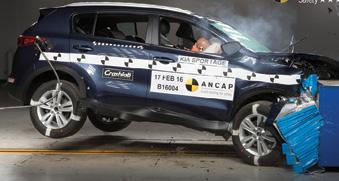
It came in below $26.5m in the same period of 2021, but ahead of the $18.2m achieved in 2020.
Reported total half-year revenue of $501m was down by 6.5 per cent from a year earlier. However, it climbed by 14.4 per cent from the same period of 2020.
Colonial’s trading profit after tax slipped to $14.2m in the past halfyear, down from $18m in the same spell of 2021.
Ash Waugh, chairman, says: “All of the company’s major
trading operations remain in good shape, with motor vehicles, heavy trucks and tractor dealerships all contributing to deliver a sound result for the period despite softening market conditions.
“While the vehicle supply shortage was showing signs of easing, waiting lists for popular models continued to pose challenges for our dealerships and meant lengthy wait times.



“The trend of shipping arrivals dictating monthly sales results remains, while at the same time the industry works through the tailend of the high vehicle demand of the past two years.”

He notes the headwinds of growing economic uncertainty, a relatively low New Zealand dollar, the cost of living and rising interest rates had softened new and used-vehicle inquiries as well as increasing business costs.
LOOKING AHEAD
Waugh says the keyword for the remainder of the financial year is “uncertainty”. While sales of popular models were expected to stay robust in the third quarter,
New Commercial Sales by Make - April 2023
New Commercial Sales by Model - April 2023
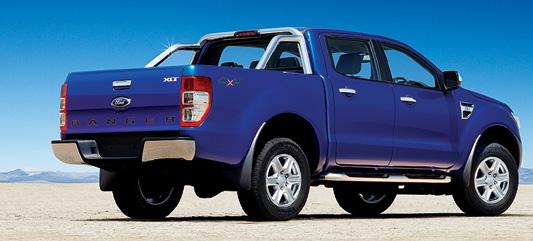
36 www.autofile.co.nz Know what’s going on in YOUR industry 0 1,000 2,000 3,000 4,000 5,000 6,000 7,000 8,000 9,000 10,000 Jan Feb Mar Apr May Jun Jul Aug Sep Oct Nov Dec 2019 2020 2021 2022 2023
New Commercial Sales - 2019-2023
MAKE APR 23 APR 22 +/- % APR '23 MKT SHARE 2023 YEAR TO DATE 2023 MKT SHARE Ford 974 305 219.3 31.2% 4,234 30.3% Toyota 895 145 517.2 28.7% 3,896 27.9% Mitsubishi 256 53 383.0 8.2% 1,111 8.0% Isuzu 174 107 62.6 5.6% 849 6.1% Fuso 107 105 1.9 3.4% 425 3.0% Nissan 104 85 22.4 3.3% 509 3.6% LDV 89 5 1,680.0 2.9% 499 3.6% Hyundai 87 12 625.0 2.8% 214 1.5% Volkswagen 49 33 48.5 1.6% 210 1.5% Hino 48 67 -28.4 1.5% 258 1.8% Mercedes-Benz 37 40 -7.5 1.2% 222 1.6% Scania 35 34 2.9 1.1% 186 1.3% Mazda 29 13 123.1 0.9% 135 1.0% Iveco 28 23 21.7 0.9% 139 1.0% DAF 27 8 237.5 0.9% 91 0.7% Ram 24 14 71.4 0.8% 104 0.7% Fiat 23 26 -11.5 0.7% 87 0.6% UD Trucks 21 25 -16.0 0.7% 94 0.7% Great Wall 14 0 1,400.0 0.4% 90 0.6% Foton 13 20 -35.0 0.4% 54 0.4% Others 83 98 -15.3 2.7% 547 3.9% Total 3,117 1,218 155.9 100.0% 13,954 100.0%
MAKE MODEL APR '23 APR '22 +/- % APR 23 MKT SHARE 2023 YEAR TO DATE 2023 MKT SHARE Ford Ranger 929 287 223.7 29.8% 3,914 28.0% Toyota Hilux 653 103 534.0 20.9% 3,133 22.5% Mitsubishi Triton 256 12 2,033.3 8.2% 1,101 7.9% Toyota Hiace 186 34 447.1 6.0% 633 4.5% Nissan Navara 104 85 22.4 3.3% 509 3.6% Isuzu D-Max 83 33 151.5 2.7% 436 3.1% Hyundai Staria Load 78 10 680.0 2.5% 181 1.3% Toyota Land Cruiser 56 8 600.0 1.8% 130 0.9% Ford Transit 45 18 150.0 1.4% 313 2.2% Isuzu N Series 41 23 78.3 1.3% 173 1.2% Isuzu F Series 38 42 -9.5 1.2% 182 1.3% LDV T60 30 0 3,000.0 1.0% 130 0.9% Mazda BT-50 29 13 123.1 0.9% 135 1.0% Hino 500 28 34 -17.6 0.9% 121 0.9% Fuso Canter 616 City 26 36 -27.8 0.8% 133 1.0% DAF CF 25 7 257.1 0.8% 86 0.6% Mercedes-Benz Sprinter 24 32 -25.0 0.8% 142 1.0% Ram 1500 23 9 155.6 0.7% 98 0.7% Fiat Ducato 22 26 -15.4 0.7% 86 0.6% Iveco Daily 21 13 61.5 0.7% 106 0.8% Others 420 393 6.9 13.5% 2,212 15.9% Total 3,117 1,218 155.9 100.0% 13,954 100.0% new commercials
the lag effect from lower levels of customer enquiry was “anticipated to have a greater impact by the fourth quarter.”
He expects the economic environment experienced in the first half will likely tighten the screws on the industry and wider retail sector as the year unfolds.
The lead-up to 2023’s general election may also result in customers deferring major purchases until a degree of certainty resumes.
Waugh says the government’s clean-car policies continue to drive demand for electric vehicles, with such models playing an increasingly dominant role in the passenger and SUV segments.

Colonial reports it has an array of new and electrified products coming to market across its brands.

“The combination of great staff,
investment in facilities and new products positions the company well to succeed,” adds Waugh.
“However, in the short to medium term we do expect a degree of turbulence as the supply of EV products remains globally scarce for the foreseeable future.”
In relation to its developments, Colonial’s upgrades at Avon City
Used Commercial Sales by Make - April 2023
Ford in Christchurch, Dunedin City Ford and Timaru Motors are all ontrack to be finished before the end of the financial year.
A brand refresh for South Auckland Mazda and Dunedin City Mazda is due to get started in 2023, and rebuilds of the Fagan Motors showroom in Masterton and of Agricentre’s
Used Commercial Sales - 2019-2023
tractor dealership in Gore are about the start. Colonial has also purchased a substantial property in Palmerston North, which it plans to develop as a long-term investment to expand and futureproof the company’s heavycommercial business in the region.
EFFECTS OF FEEBATES FELT
There were 3,117 new commercials registered last month. The total was up by 155.9 per cent on 1,218 in April 2022, the first month of the full clean car discount scheme.
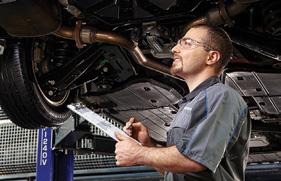


The Ford Ranger was the top model with 929 units. Toyota’s Hilux was second on 653 and Mitsubishi’s Triton took out third with 256.
As for used-imported commercials, there were 429 registered in April compared with 277 in the same month of last year for a rise of 54.9 per cent.
Used Commercial Sales by Model - April 2023
www.autofile.co.nz 37
0 500 1,000 1,500 2,000 2,500 Jan Feb Mar Apr May Jun Jul Aug Sep Oct Nov Dec 2019 2020 2021 2022 2023
MAKE APR '23 APR '22 +/- % APR '23 MKT SHARE 2023 YEAR TO DATE 2023 MKT SHARE Toyota 198 53 273.6 46.2% 777 41.4% Nissan 84 27 211.1 19.6% 421 22.4% Isuzu 41 38 7.9 9.6% 120 6.4% Hino 29 54 -46.3 6.8% 141 7.5% Mitsubishi 23 30 -23.3 5.4% 111 5.9% Ford 16 12 33.3 3.7% 77 4.1% Daihatsu 10 10 0.0 2.3% 32 1.7% Mazda 5 3 66.7 1.2% 25 1.3% DAF 4 0 400.0 0.9% 7 0.4% Suzuki 4 6 -33.3 0.9% 17 0.9% UD Trucks 3 7 -57.1 0.7% 15 0.8% Dodge 2 1 100.0 0.5% 6 0.3% Volkswagen 2 3 -33.3 0.5% 10 0.5% Fiat 1 1 0.0 0.2% 10 0.5% Freightliner 1 1 0.0 0.2% 3 0.2% Fuso 1 2 -50.0 0.2% 5 0.3% Holden 1 6 -83.3 0.2% 20 1.1% Honda 1 1 0.0 0.2% 5 0.3% Iveco 1 3 -66.7 0.2% 9 0.5% Kenworth 1 0 100.0 0.2% 6 0.3% Others 1 19 -94.7 0.2% 60 3.2% Total 429 277 54.9 100.0% 1,877 100.0%
MAKE MODEL APR 23 APR '22 +/- % APR '23 MKT SHARE 2023 YEAR TO DATE 2023 MKT SHARE Toyota Hiace 148 16 825.0 34.5% 545 29.0% Nissan NV350 55 6 816.7 12.8% 266 14.2% Isuzu Elf 30 23 30.4 7.0% 81 4.3% Hino Dutro 25 36 -30.6 5.8% 106 5.6% Toyota Dyna 19 25 -24.0 4.4% 72 3.8% Toyota Regius 19 1 1,800.0 4.4% 94 5.0% Fuso Canter 15 20 -25.0 3.5% 76 4.0% Nissan Caravan 12 3 300.0 2.8% 62 3.3% Daihatsu Hijet 10 10 0.0 2.3% 32 1.7% Ford Ranger 8 3 166.7 1.9% 38 2.0% Isuzu Forward 8 10 -20.0 1.9% 29 1.5% Toyota Hilux 5 3 66.7 1.2% 22 1.2% Mazda Titan 4 2 100.0 0.9% 13 0.7% Nissan Civilian 4 3 33.3 0.9% 15 0.8% Suzuki Carry 4 6 -33.3 0.9% 17 0.9% Toyota Toyoace 4 6 -33.3 0.9% 30 1.6% Mitsubishi Fuso 3 1 200.0 0.7% 9 0.5% Mitsubishi Rosa 3 4 -25.0 0.7% 11 0.6% Nissan Atlas 3 5 -40.0 0.7% 26 1.4% Nissan Navara 3 1 200.0 0.7% 10 0.5% Others 47 93 -49.5 11.0% 323 17.2% Total 429 277 54.9 100.0% 1,877 100.0% Subscribe now at www.autofile.co.nz/subscribe INSIGHT Keep up to date with the latest automotive news used commercials t
Clean-car changes to alter market
The chief executive of Toyota NZ says changes to the clean car discount (CCD) announced on May 5 have the potential to affect the affordability of low-emissions technology.
“Many of our customers have placed orders in good faith with a clear idea of what the rebate or fee will be as part of their affordability decision,” says Neeraj Lala.
Many buyers have waited extended periods for their cars due to Toyota NZ being unable to supply them fast enough and he adds they will now be penalised by lower rebates or higher fees from July 1 with little notice.
“The CCD is a relationship between the government and consumers, but ultimately this decision impacts on their relationship with our brand.
“We remain concerned that
sectors, such as agriculture or construction, are being penalised by a significant fee increase when there are no suitable low-emissions options available.
“The fee increase on these models is significant and will affect the affordability of models these customers need for their livelihoods.”
Toyota NZ is disappointed that some high-volume petrol hybrids are being removed from the rebate scheme “given the high impact of decarbonisation and affordability they deliver without range anxiety”.
“Hybrids are a good transitionary technology,” says Lala. “We will continue to offer them alongside our next generation of battery electric vehicles [BEVs] over the next 18 months.
“The increase of hybrids and other electrified options in Toyota’s

Dealer stock of new cars in New Zealand
line-up has already reduced tailpipe emissions from our vehicles by 16 per cent over the past four years.
“We are focused on the impact of our line-up. This means we will continue to move all our models to low-emissions versions whether that be hybrid or battery-electric technology. It’s about what is appropriate for that vehicle and customer needs.”
As for a previous government announcement on canning the clean car upgrade, Lala describes that as a “huge mistake”.
Essentially a scrappage policy, it could have been a “rock star” if it had gone ahead and would have allowed people to shift to lowemissions vehicles.
Lala warns ditching that and a car-leasing scheme will lead to older models staying on our roads for longer.
Sales decrease
Imports of new cars in April came in at 6,359. This was down by 25.7 per cent from the same month a year earlier and 17.4 per cent lower than March’s total of 7,698 units.
Registrations of 7,061 new passenger vehicles were completed last month, which was down 17.1 per cent from April 2022. It also represented a 39.2 per cent decrease from 11,618 units in March.
The numbers have resulted in the stock of new cars still to be registered dropping by 702 to 77,026. Daily registrations, as averaged over the previous 12 months, stand at 313 units per day – up from 304 a year earlier.
April’s results mean stock athand has increased to 246 days, or 8.1 months, if sales continue at the current rate. In the same month of 2022, stock at-hand stood at 271 days.
38 www.autofile.co.nz
CAR SALES VARIANCE STOCK DAILY SALES - 12-MONTH AVERAGE DAYS STOCK AT HAND IMPORTED REGISTERED Apr ‘22 8,555 8,519 36 82,403 304 271 May ‘22 8,488 10,552 -2,064 80,339 306 263 Jun ‘22 9,439 9,537 -98 80,241 304 264 Jul ‘22 9,368 8,033 1,335 81,576 298 273 Aug ‘22 9,928 10,924 -996 80,580 316 255 Sep ‘22 11,219 10,588 631 81,211 312 260 Oct ‘22 12,011 10,740 1,271 82,482 316 261 Nov ‘22 11,493 11,161 332 82,814 316 262 Dec ‘22 9,936 8,492 1,444 84,258 319 264 Jan ‘23 5,985 9,259 -3,274 80,984 320 253 Feb ‘23 6,912 6,248 664 81,648 316 259 Mar ‘23 7,698 11,618 -3,920 77,728 317 245 Apr ‘23 6,359 7,061 -702 77,026 313 246 Year to date 26,954 34,186 Change on last month -17.4% -39.2% -0.9% Change on Apr 2022 -25.7% -17.1% -6.5% LESS IMPORTED LESS SOLD LESS STOCK DAYS STOCK IN NZ - NEW CARS 340 320 300 280 260 240 220 200 180 0 APR MAY JUN JUL AUG SEP OCT NOV DEC JAN FEB MAR APR Days of stock
Fast. Reliable. What more would you need?
April 2022 — April
April
— April
2023
2021
2022
Fixing plug-in hybrid oddity Stock growing
The Imported Motor Vehicle Industry Association (VIA) is pleased an anomaly with the way plug-in hybrids (PHEVs) are dealt with under the clean-car policies will be addressed by Waka Kotahi.
At the moment, used PHEVs are assessed for their carbon dioxide (CO2) emissions by Waka Kotahi in a different way to new vehicles. This affects the ratings that are then used for the clean car discount (CCD) and clean car standard (CCS).
Kit Wilkerson, VIA’s head of policy and strategy, says: “We have long raised the problem with the NZTA about used PHEVs. This is finally being fixed although we don’t yet know when the changes will take place.”
When new PHEVs are imported, their effective EV ranges are taken into account for the CCD and CCS.
However, that hasn’t been the case with used plug-in hybrids, which have been strictly held to information published in Japan.
“The way Japan calculates their efficiency doesn’t include the electric-only range of models, such as the Toyota Prius PHEV,” explains Wilkerson. “Whether this model is imported new or imported from Japan as used, it’s essentially the same car.”
The CO2 values applied on PHEVs for the clean-car programme have been 20g/km for new and 87g/km for used.
“It means anyone who has bought a used-imported Prius PHEV in the past few years has effectively been short-changed.”
Wilkerson emphasises Waka Kotahi has needed to follow the rules in this way. But they are now being rewritten by the transport
agency, which is developing a way to take used PHEVs’ electric ranges into account in the same way it does for the new-vehicle industry.
“There may be some small differences because the new-car sector uses the NEDC while the JC08 testing regime applies to used imports,” he adds. “Sometimes, this may benefit used, sometimes it may be detrimental, but generally it will be equitable.”
Visit www.autofile.co.nz for more in-depth coverage on the CCD. We talk to David Vinsen, VIA’s chief executive, who says the changes aren’t unexpected “because we always knew the scheme would run out of money.”
He recalls a discussion back in February 2018 with the Greens’ Julie Anne Genter, Associate Minister of Transport at the time, and raising that very issue.
There were 8,775 used cars imported last month, a jump of 9.7 per cent from 7,999 in the same month a year earlier. However, the latest total was down by 23.3 per cent from March when 11,445 units crossed our borders.
A total of 7,945 units were registered last month. This was 22.3 per cent more than the 6,497 units in April last year but down 17.9 per cent from 9,678 in March.
With 830 more used cars imported than registered last month, it brought unregistered stock on dealers’ yards or in compliance shops to 14,312 units. This was 26 per cent higher than the 11,357 a year ago.
Average daily registrations rose month-on-month to 251, although this was down from 367 a year ago, and there is 57 days’ stock remaining.
Dealer stock of used cars in New Zealand
We pride ourselves on speed of delivery
Our aim is to ensure we ship your vehicles as fast as we can cutting out unnecessary and costly delays. With spaces available on next vessel direct sailings from Japan to New Zealand our speed of delivery won’t slow your business down.
www.autofile.co.nz 39
CAR SALES VARIANCE STOCK DAILY SALES - 12-MONTH AVERAGE DAYS STOCK AT HAND IMPORTED REGISTERED Apr ‘22 7,999 6,497 1,502 11,357 367 31 May ‘22 11,833 6,875 4,958 16,315 355 46 Jun ‘22 8,649 7,402 1,247 17,562 344 51 Jul ‘22 6,498 8,232 -1,734 15,828 331 48 Aug ‘22 8,594 7,933 661 16,489 333 50 Sep ‘22 5,096 7,365 -2,269 14,220 333 43 Oct ‘22 5,064 7,234 -2,170 12,050 324 37 Nov ‘22 6,297 7,151 -854 11,196 312 36 Dec ‘22 9,781 6,985 2,796 13,992 304 46 Jan ‘23 5,082 7,137 -2,055 11,937 296 40 Feb ‘23 7,538 7,760 -222 11,715 287 41 Mar ‘23 11,445 9,678 1,767 13,482 247 55 Apr ‘23 8,775 7,945 830 14,312 251 57 Year to date 32,840 32,520 Change on last month -23.3% -17.9% 6.2% Change on Apr 2022 9.7% 22.3% 26.0% MORE IMPORTED MORE SOLD MORE STOCK DAYS STOCK IN NZ - USED CARS 180 160 140 120 100 80 60 40 20 APR MAY JUN JUL AUG SEP OCT NOV DEC JAN FEB MAR APR Days of stock www.moana-blue.com
MOANA
622)
0800
BLUE (0800 662
April 2022 — April 2023 April 2021 — April 2022

www.autohub.co +64 9 411 7425 info@autohub.co.nz GIVE AUTOHUB A CALL GLOBAL VEHICLE LOGISTICS NZ - JAPAN - AUSTRALIA - UK - SINGAPORE WE NEVER STOP LOOKING FOR BETTER WAYS TO GET YOUR VEHICLES DELIVERED

























































































































